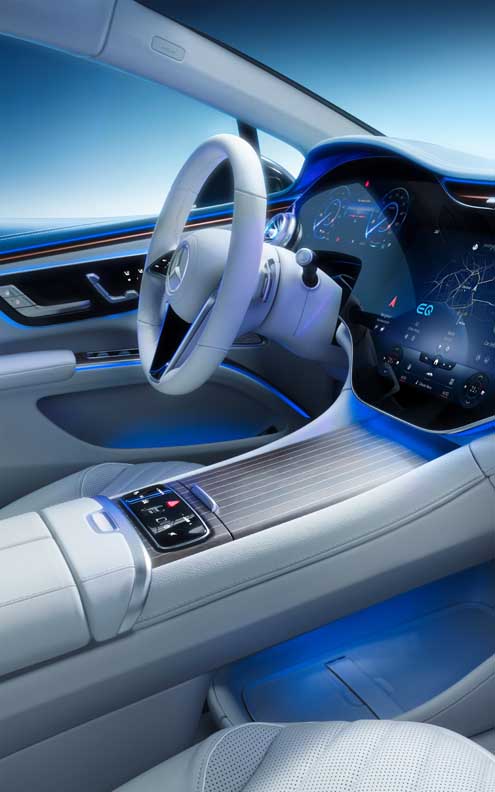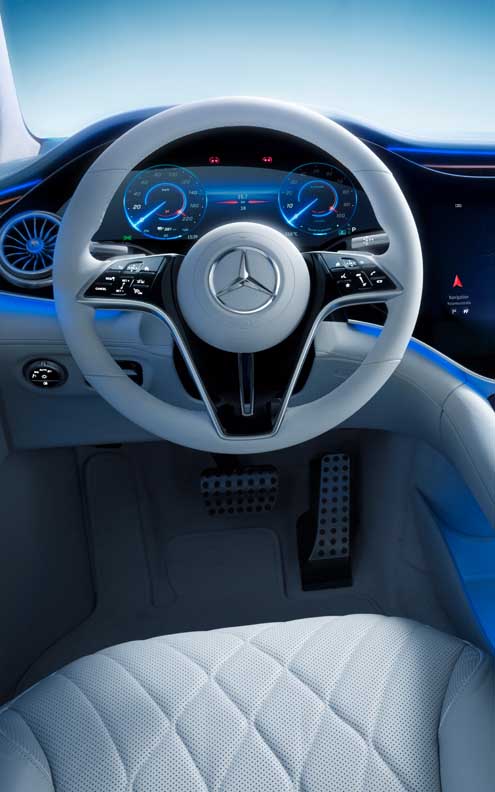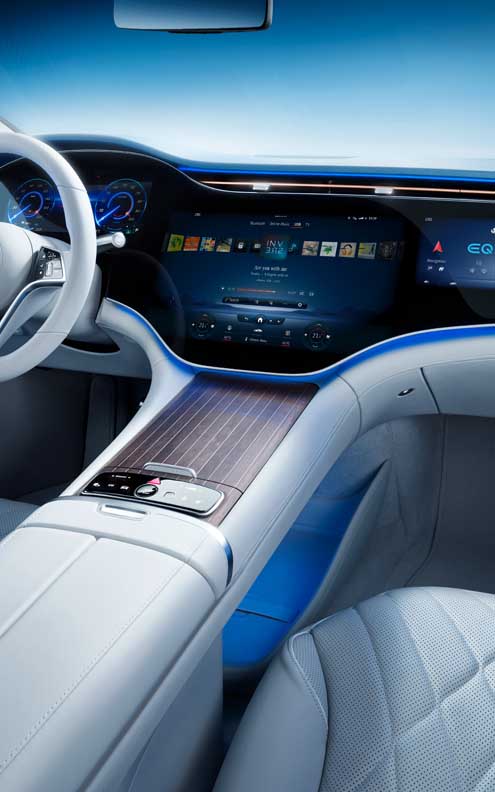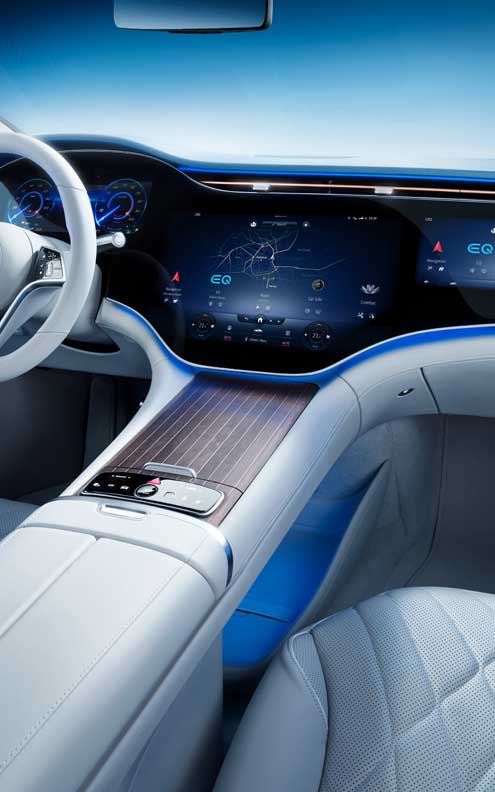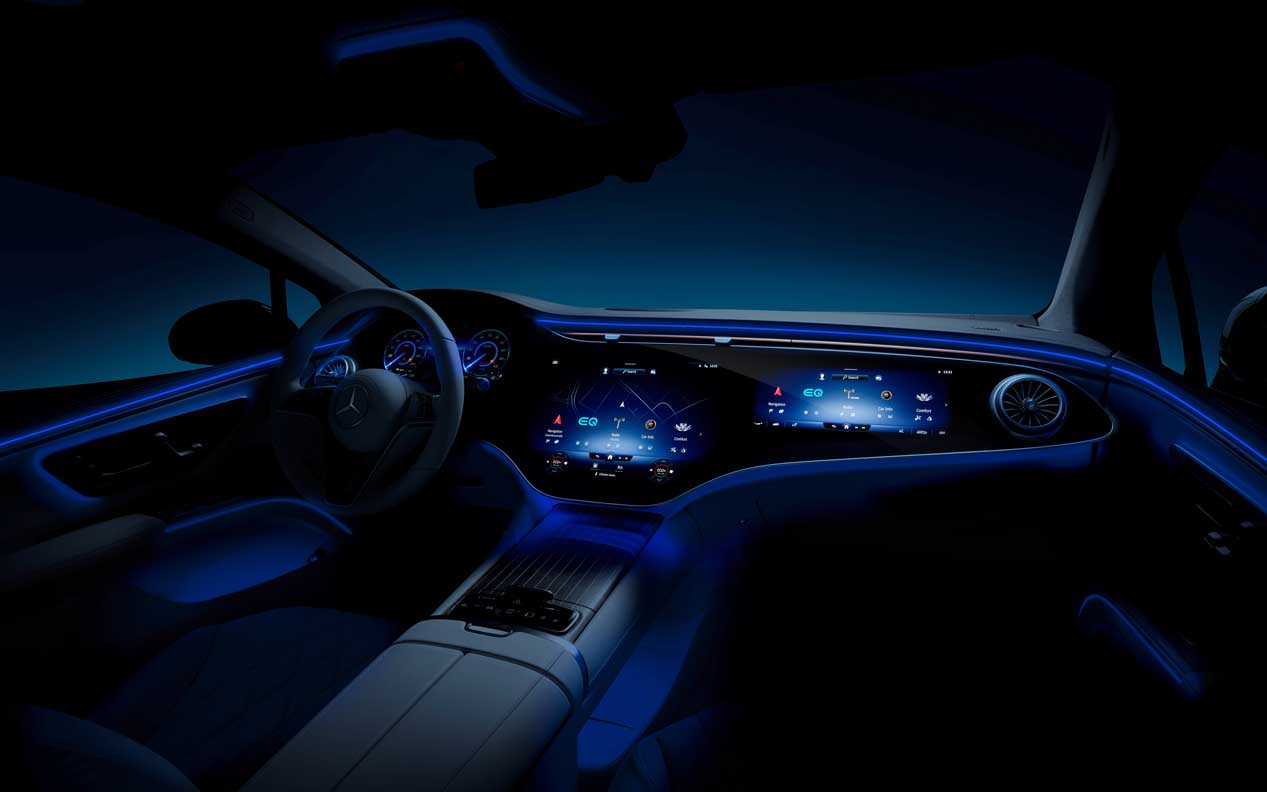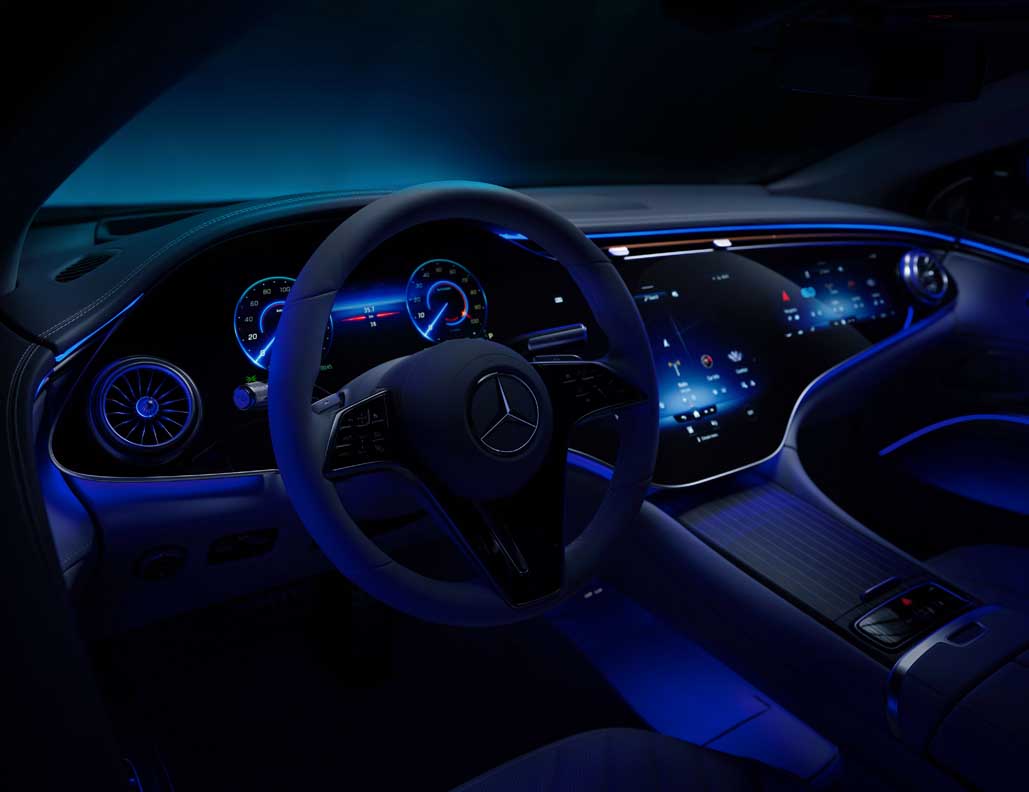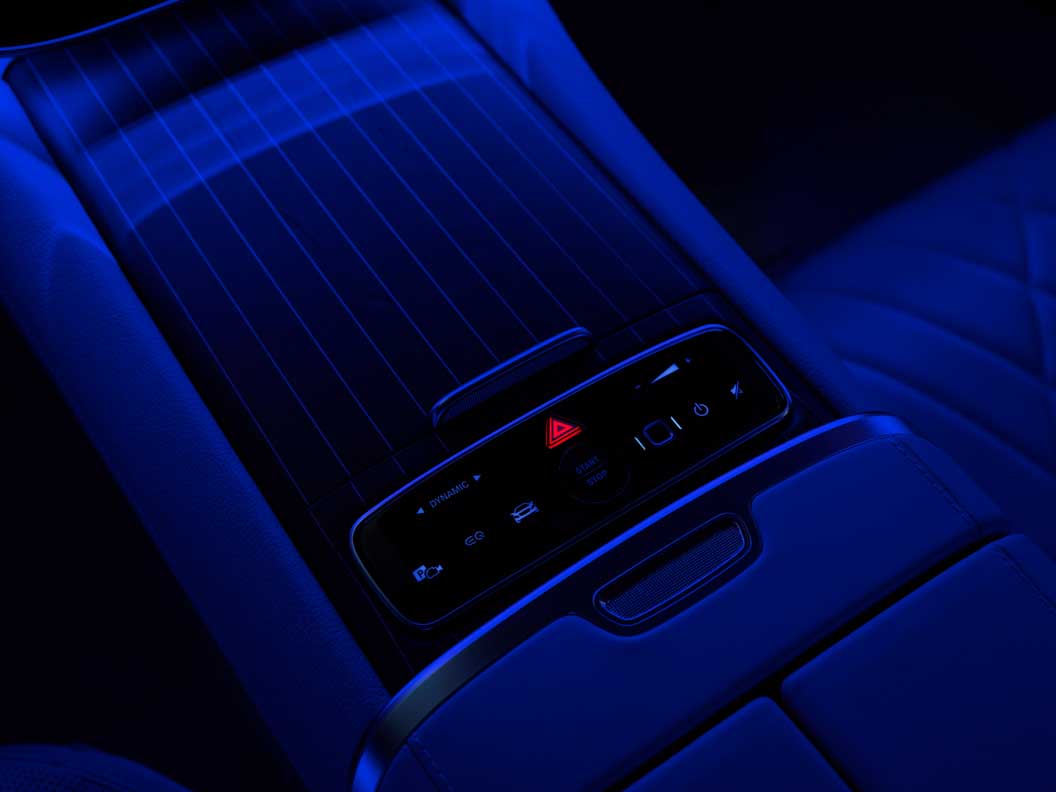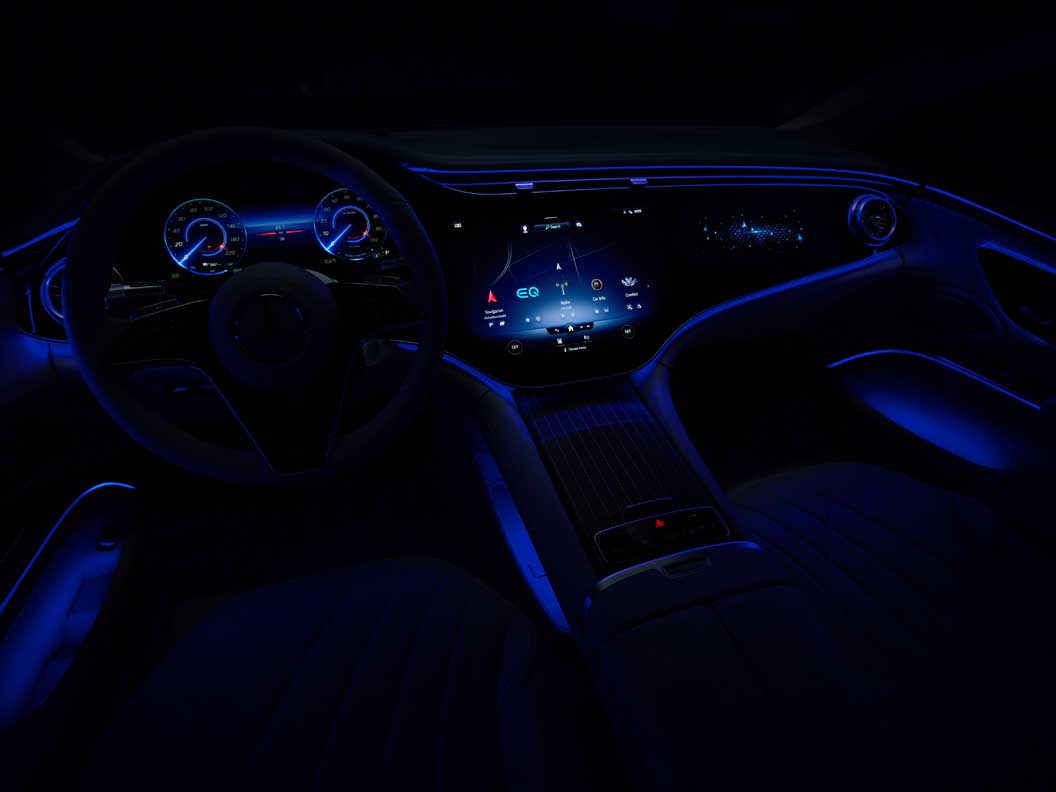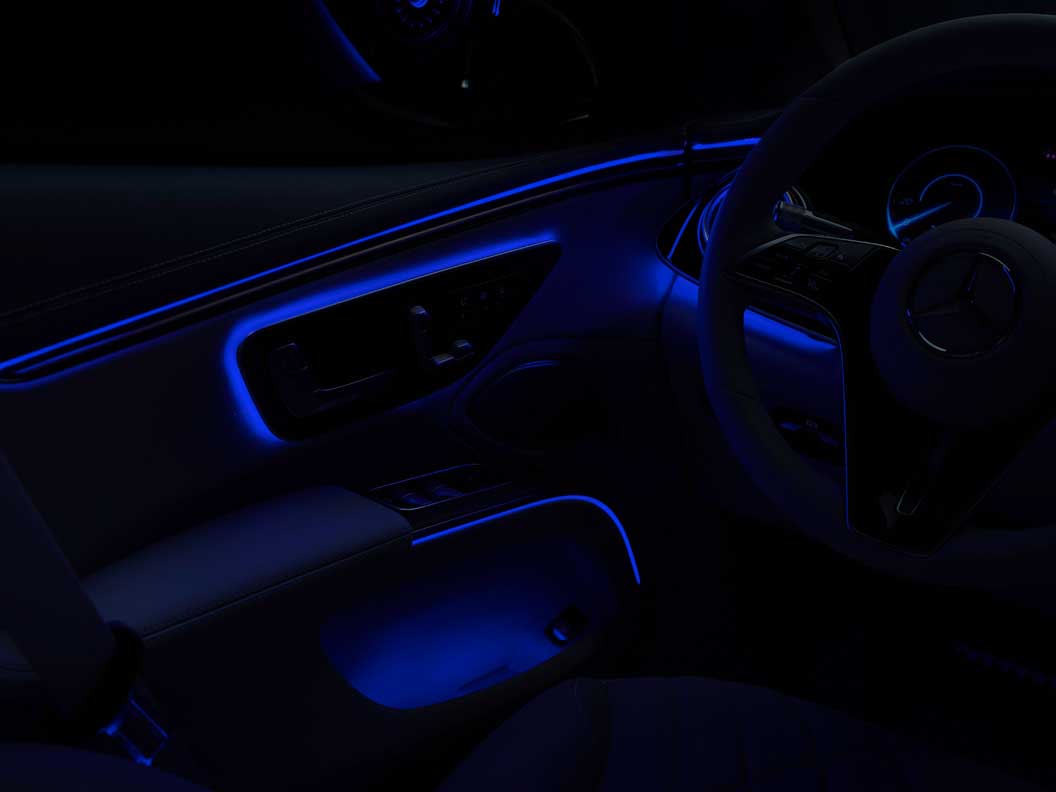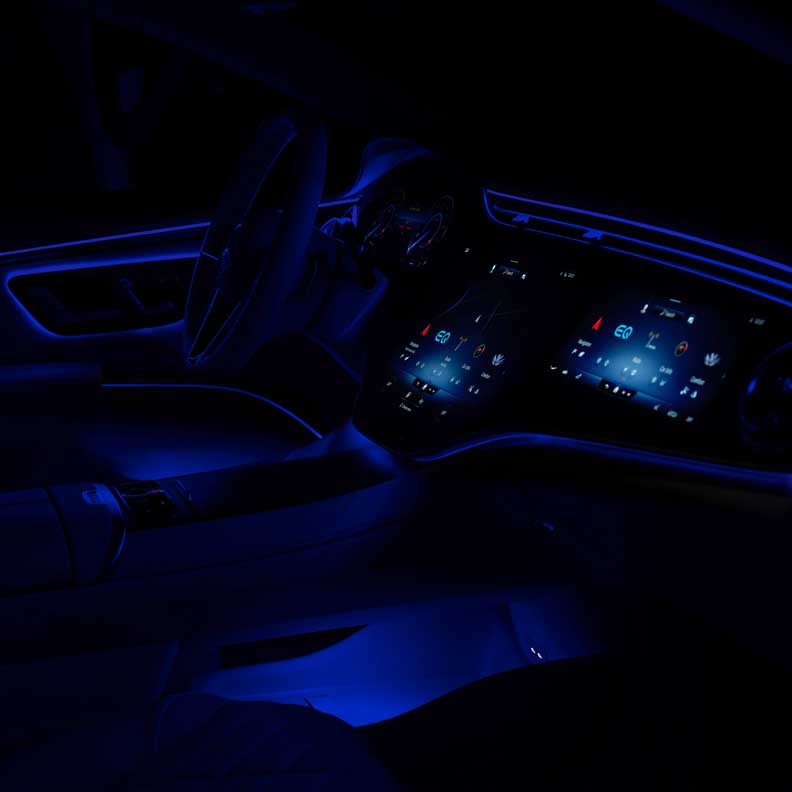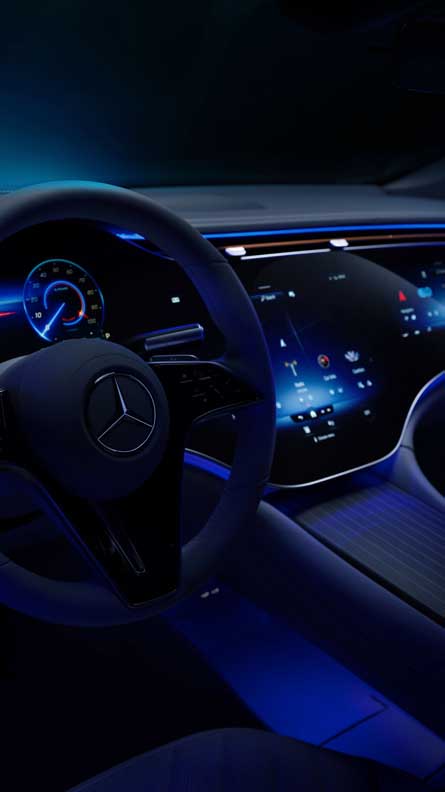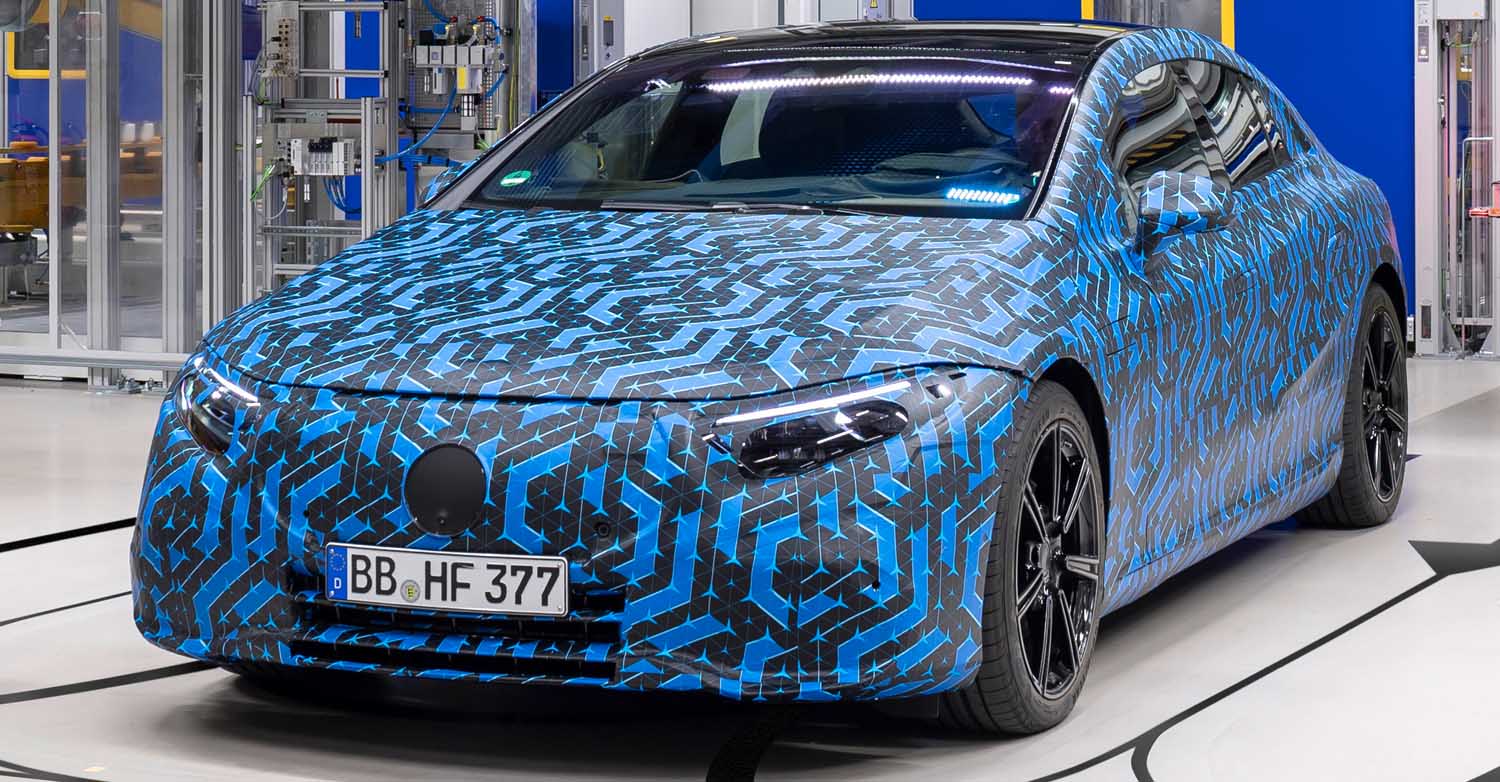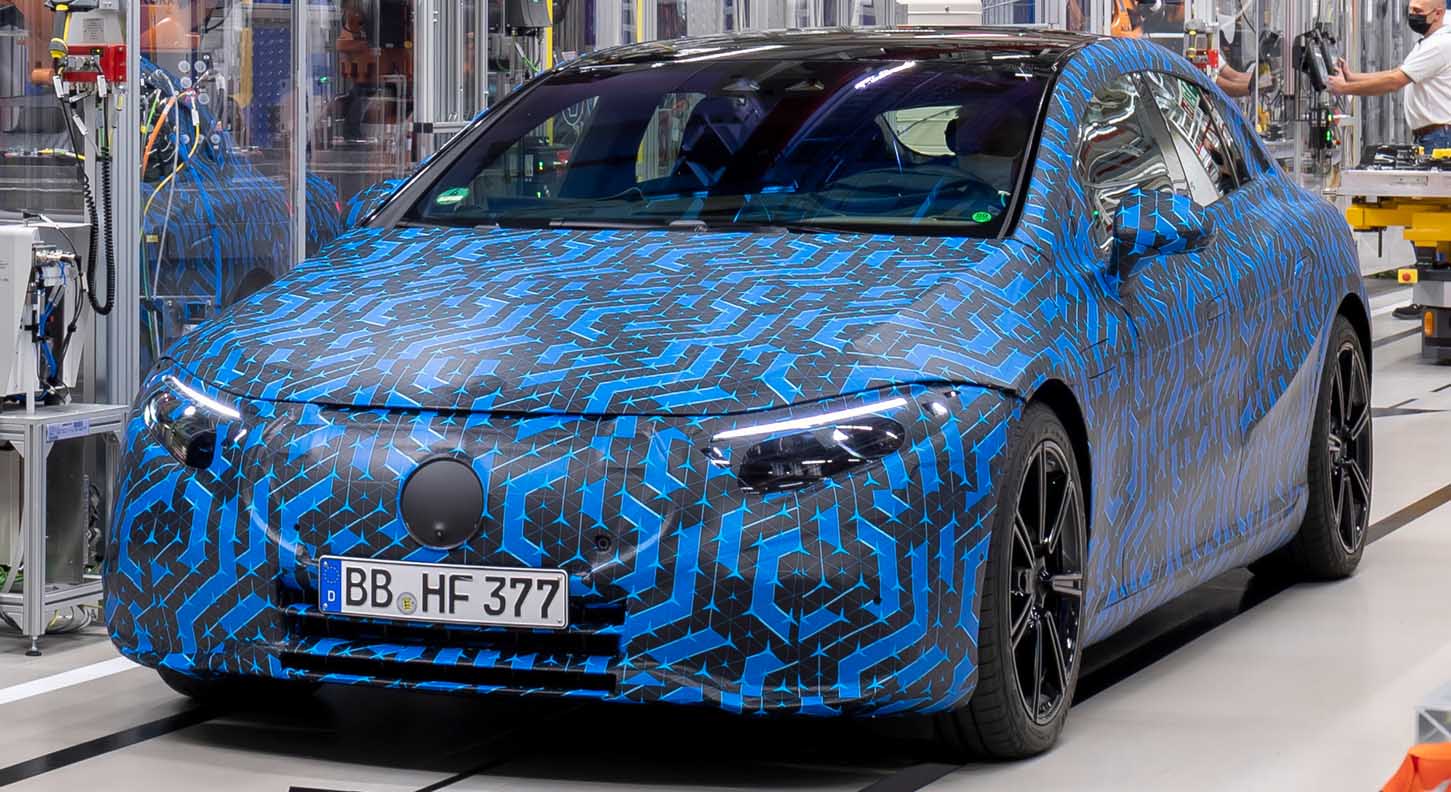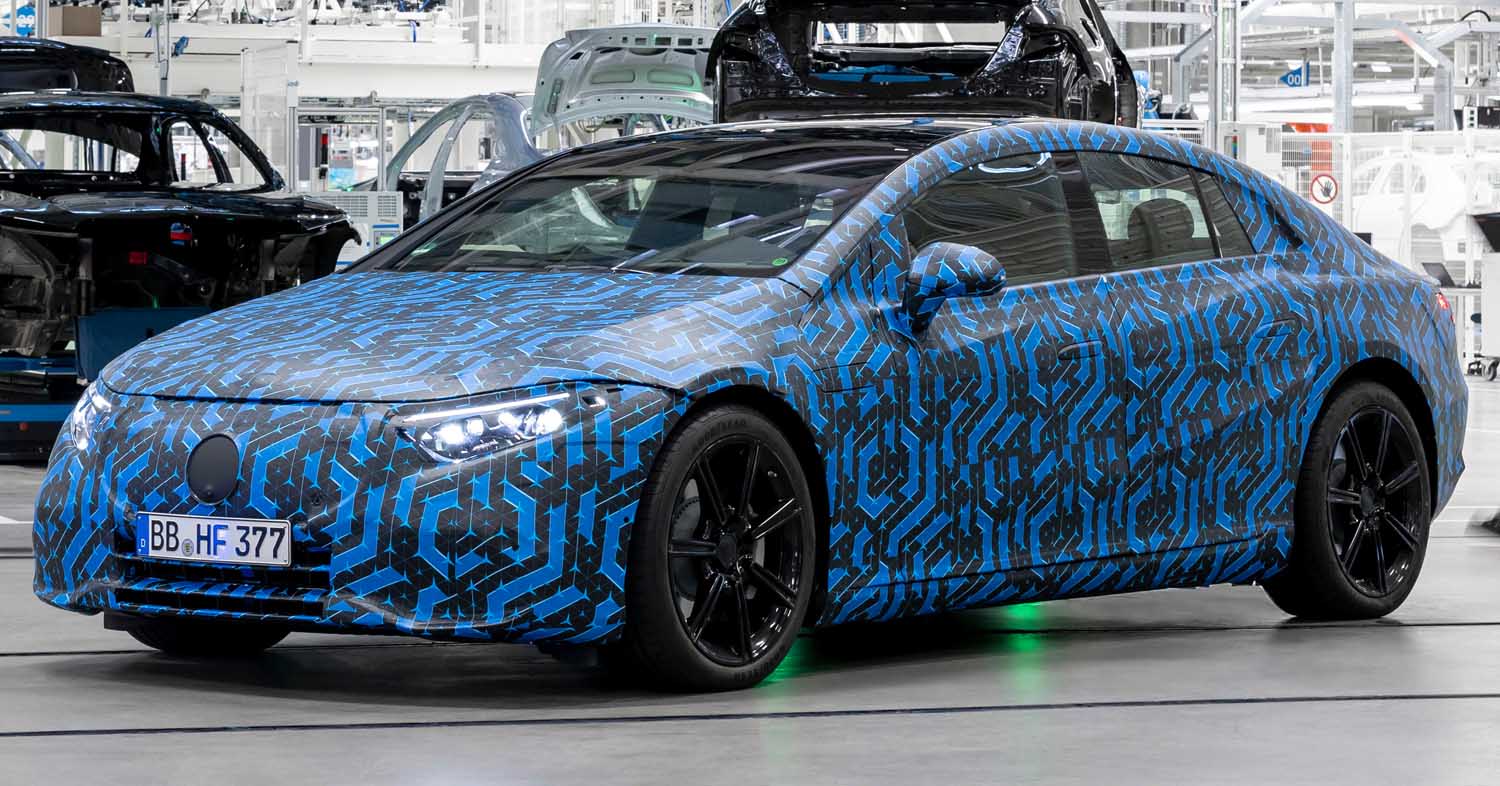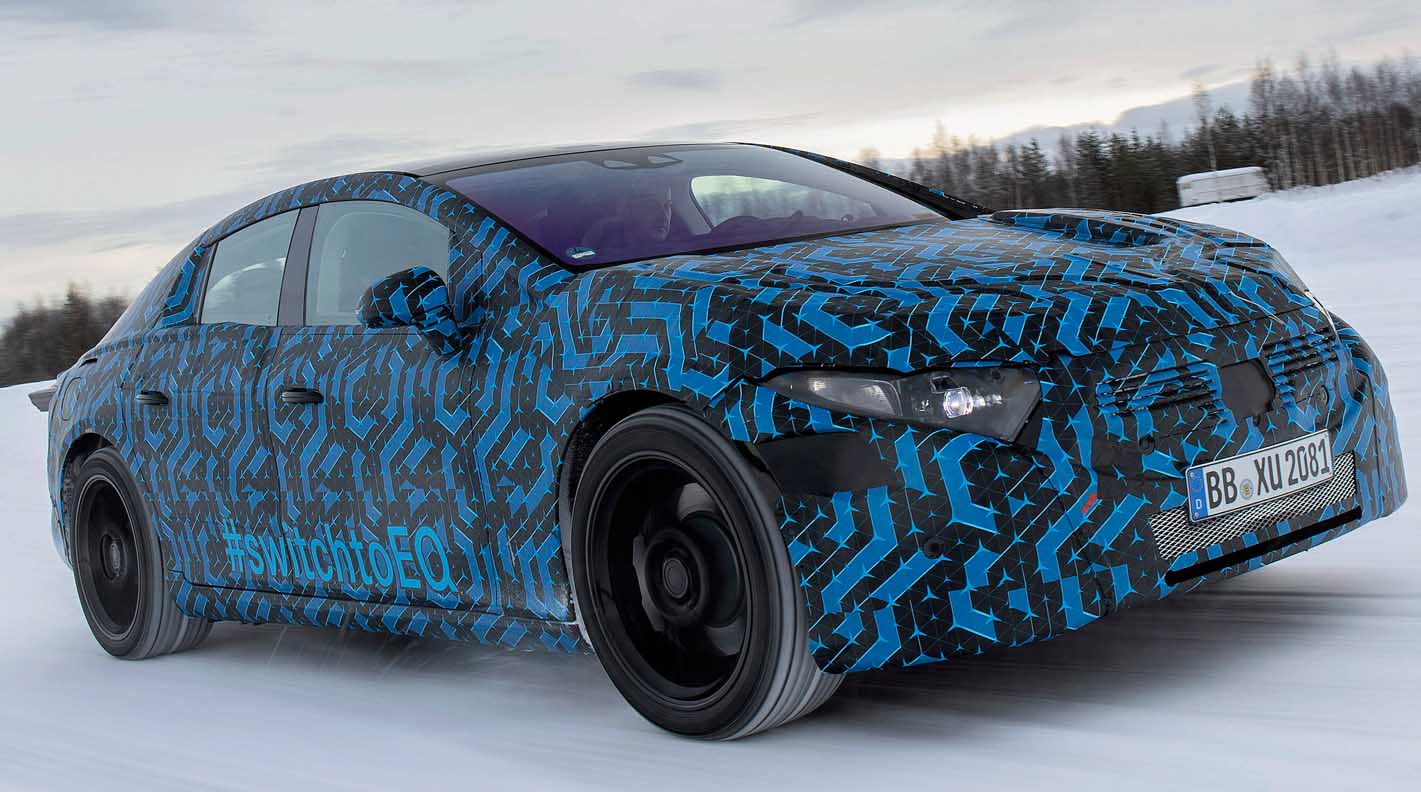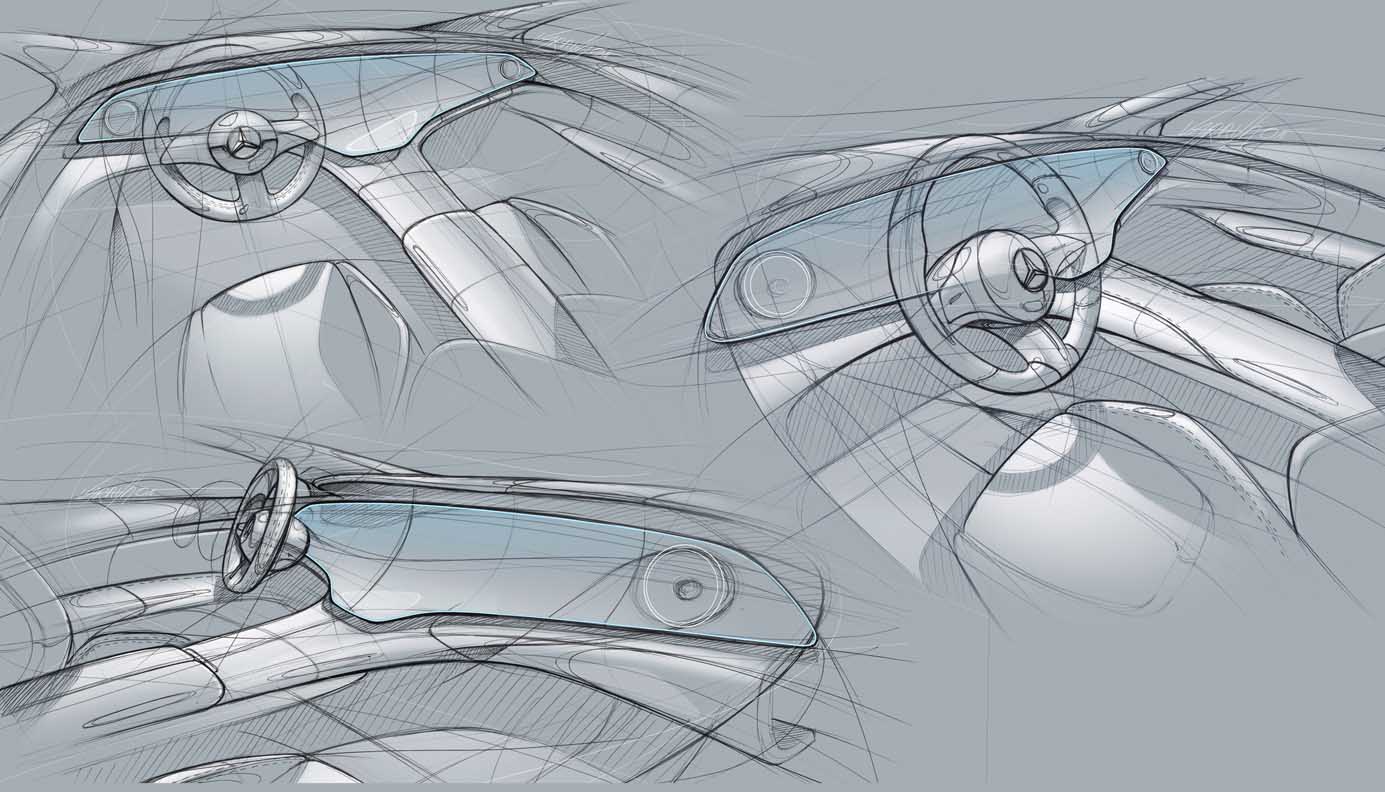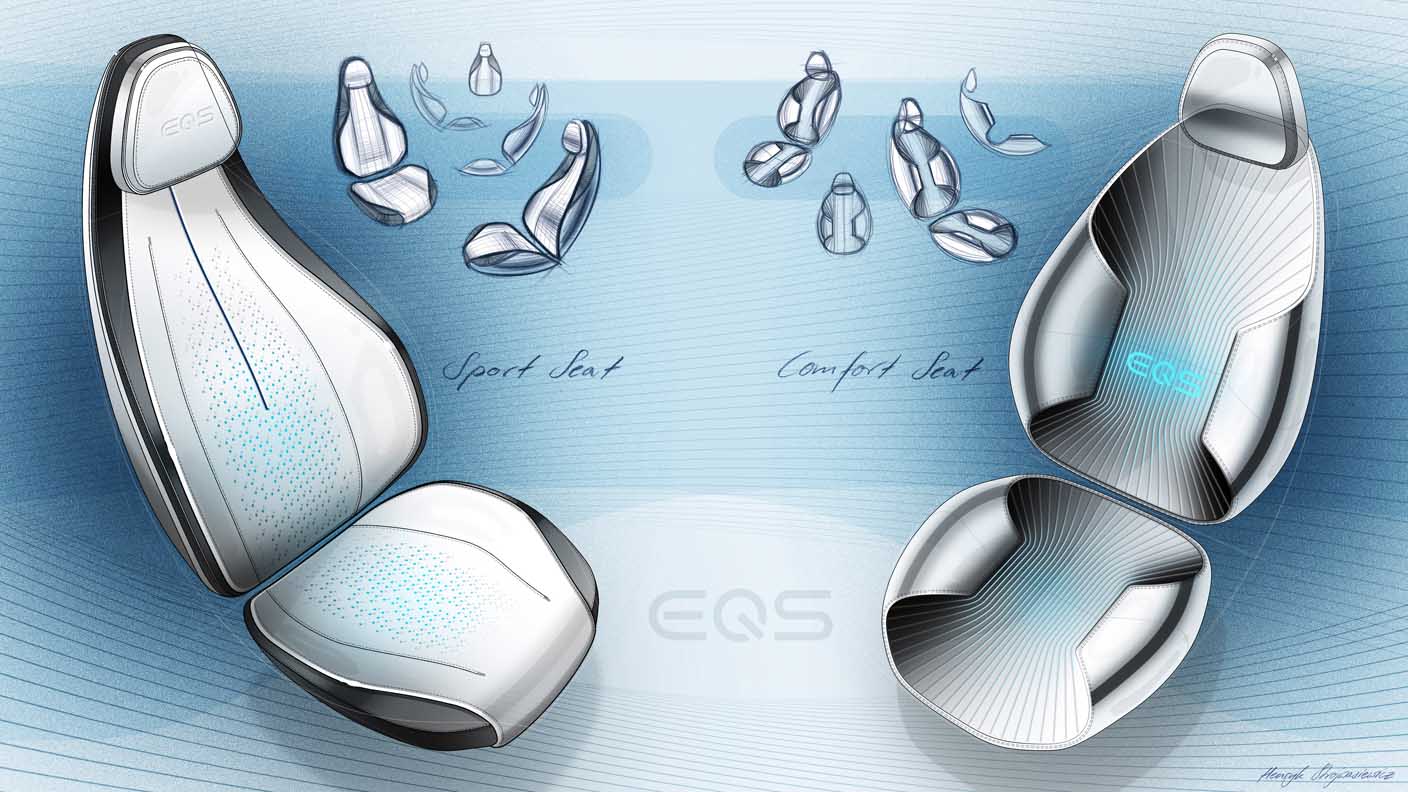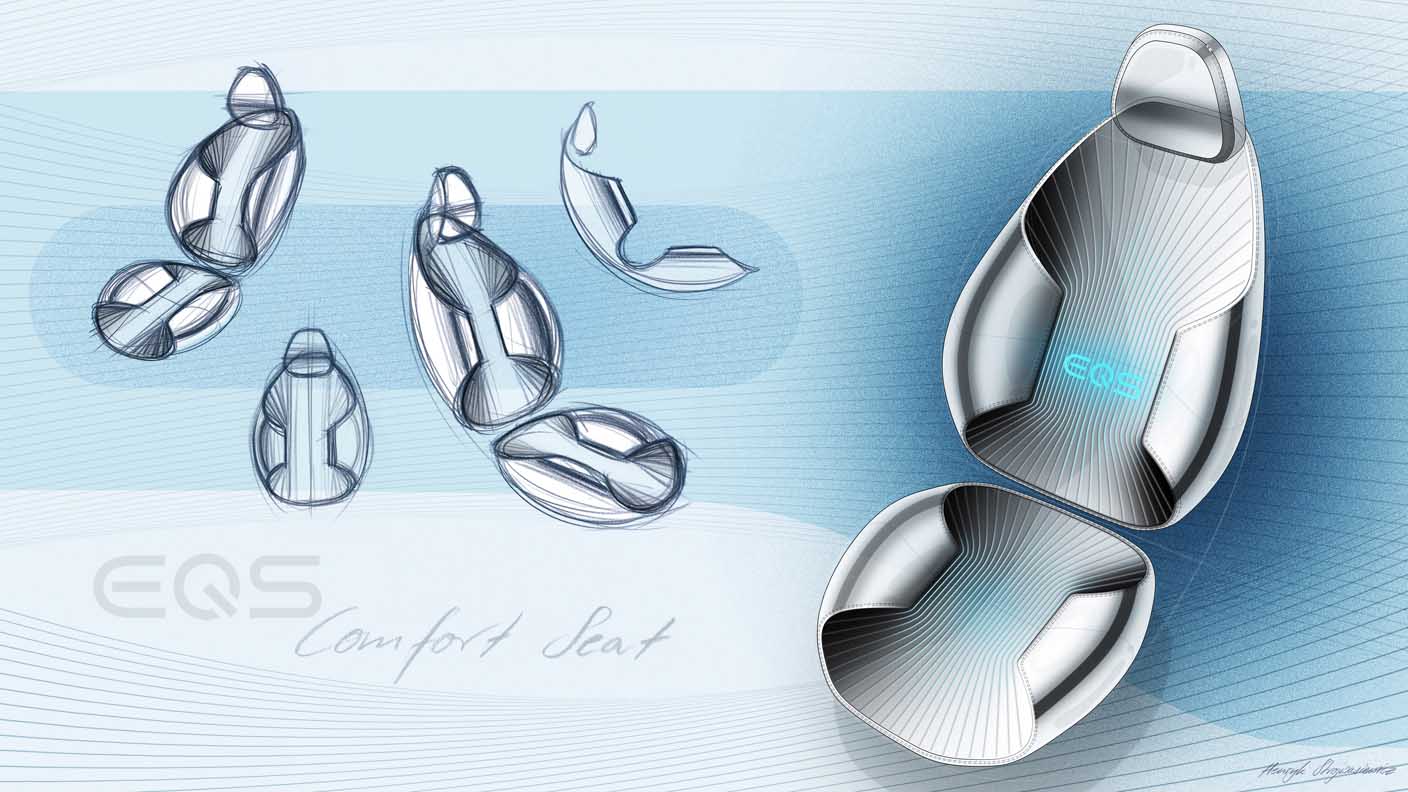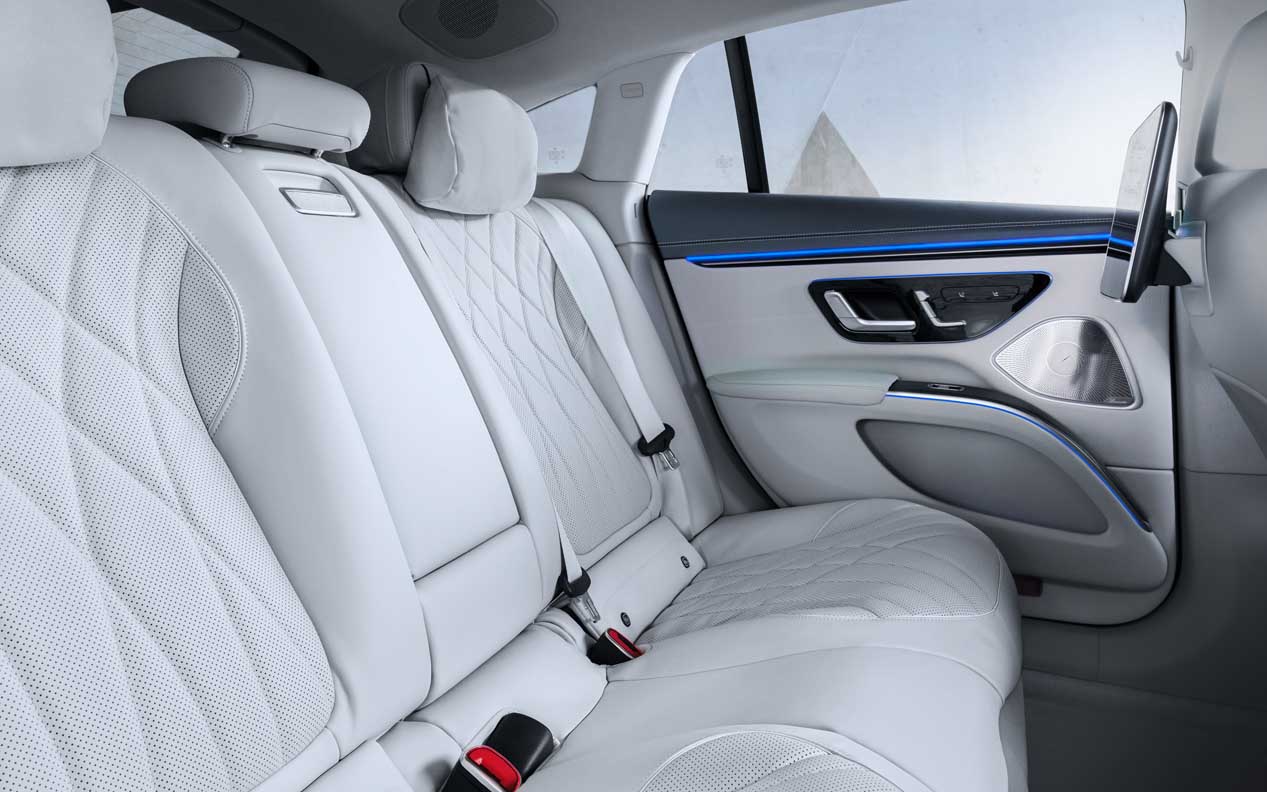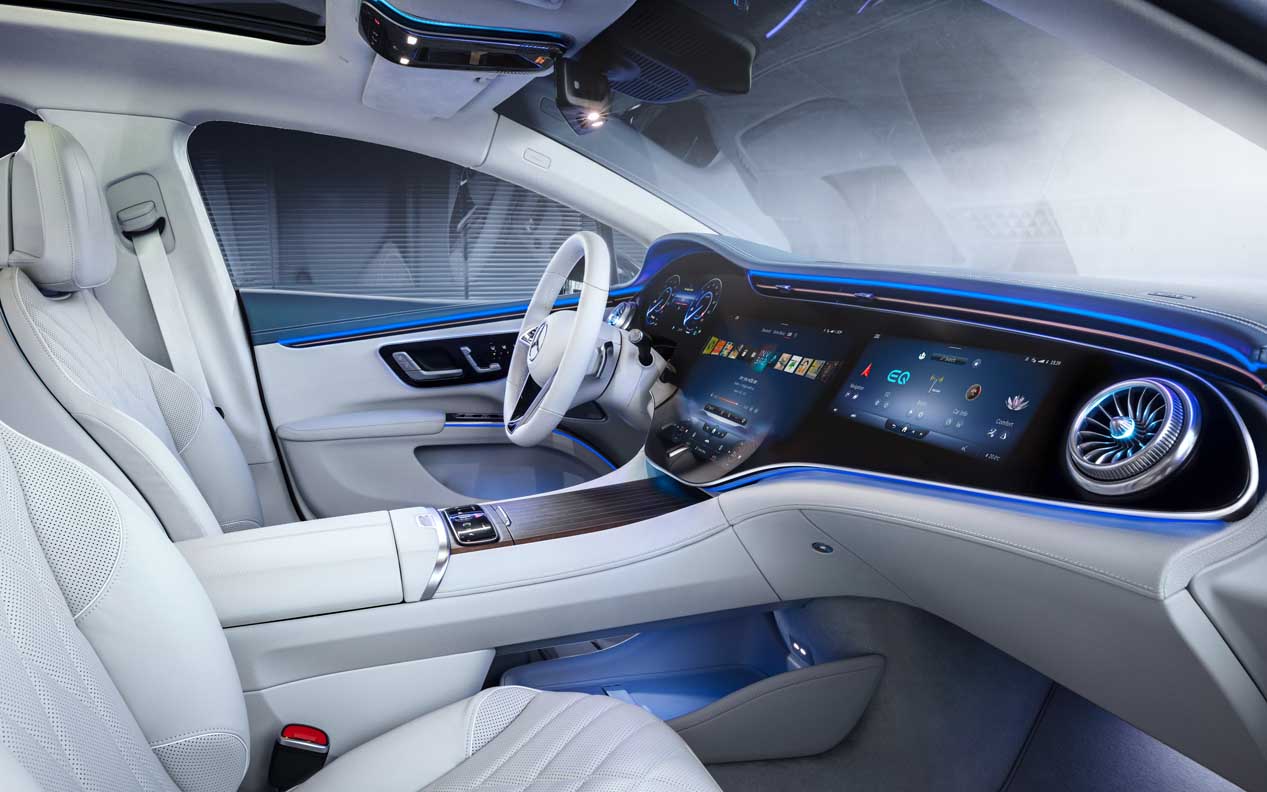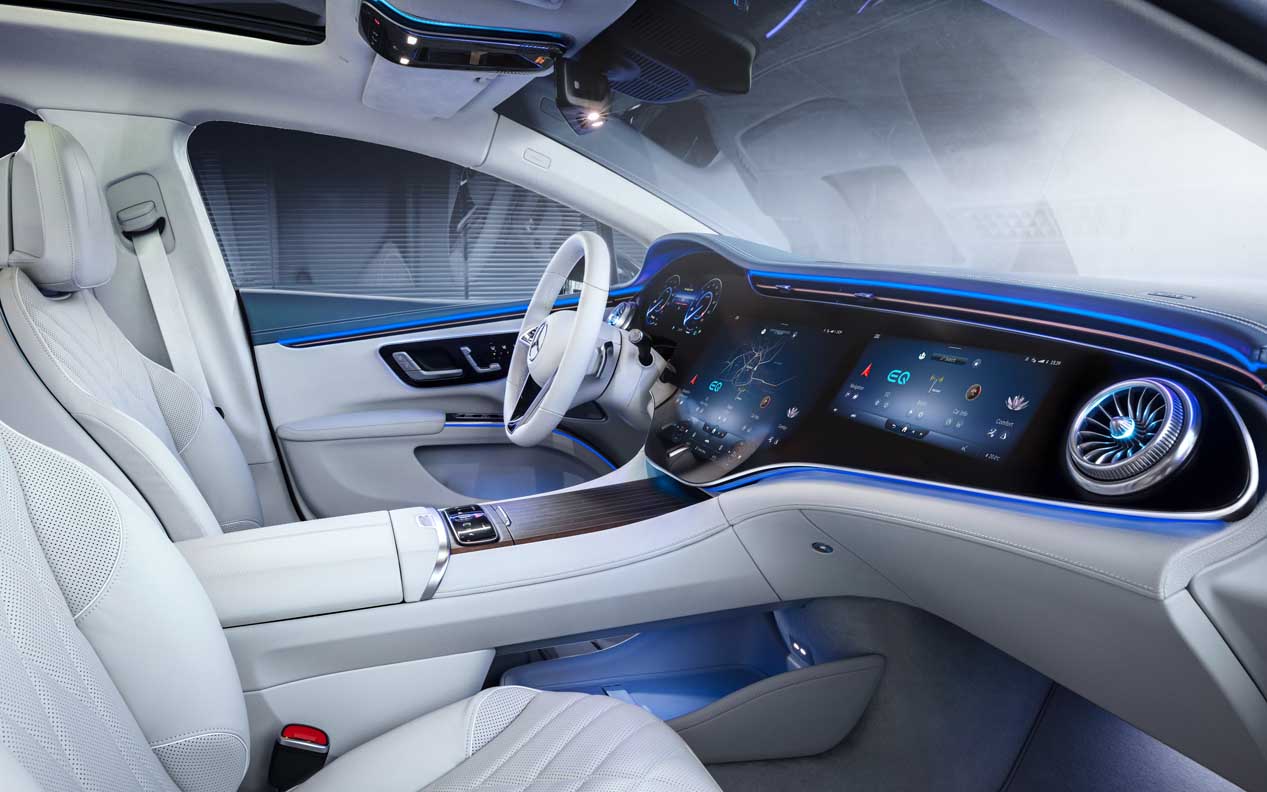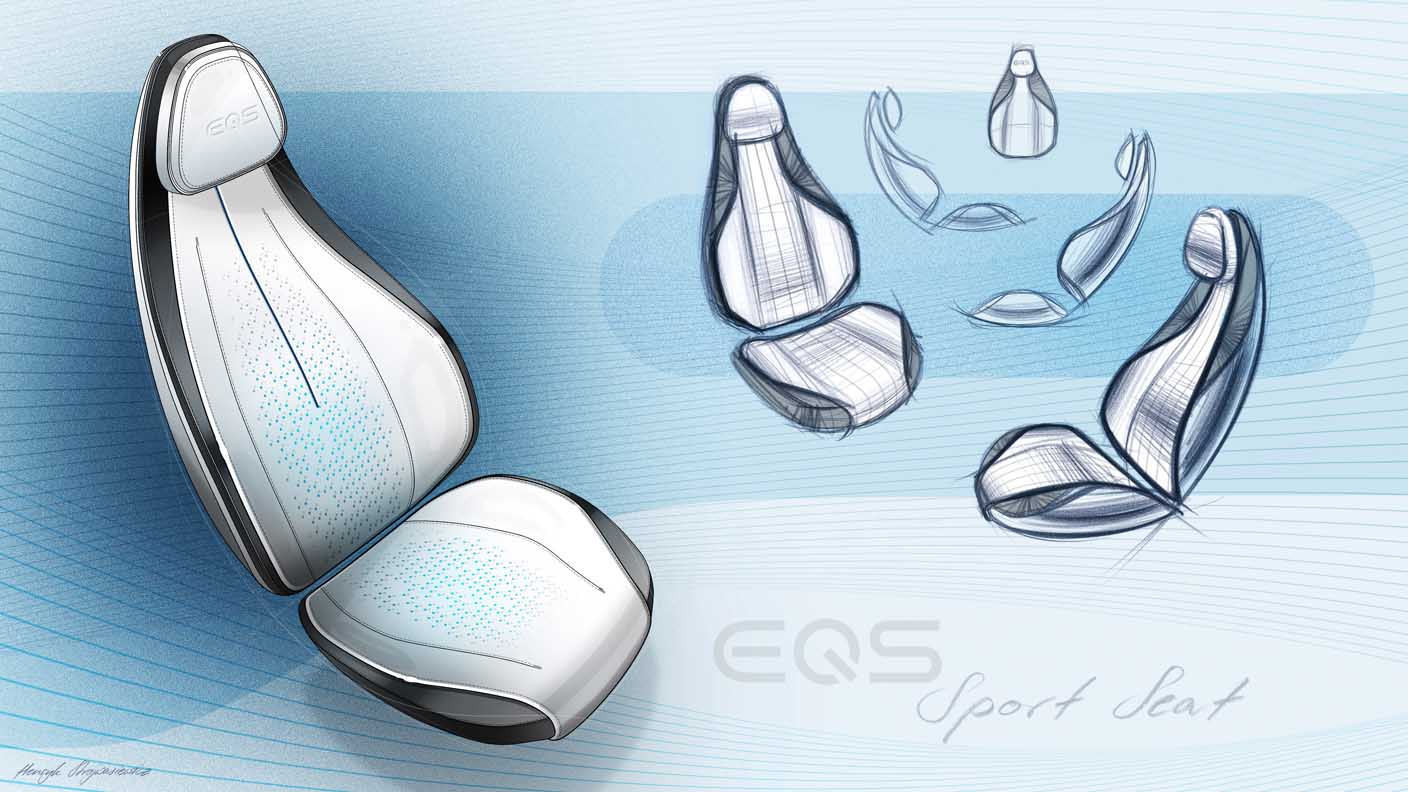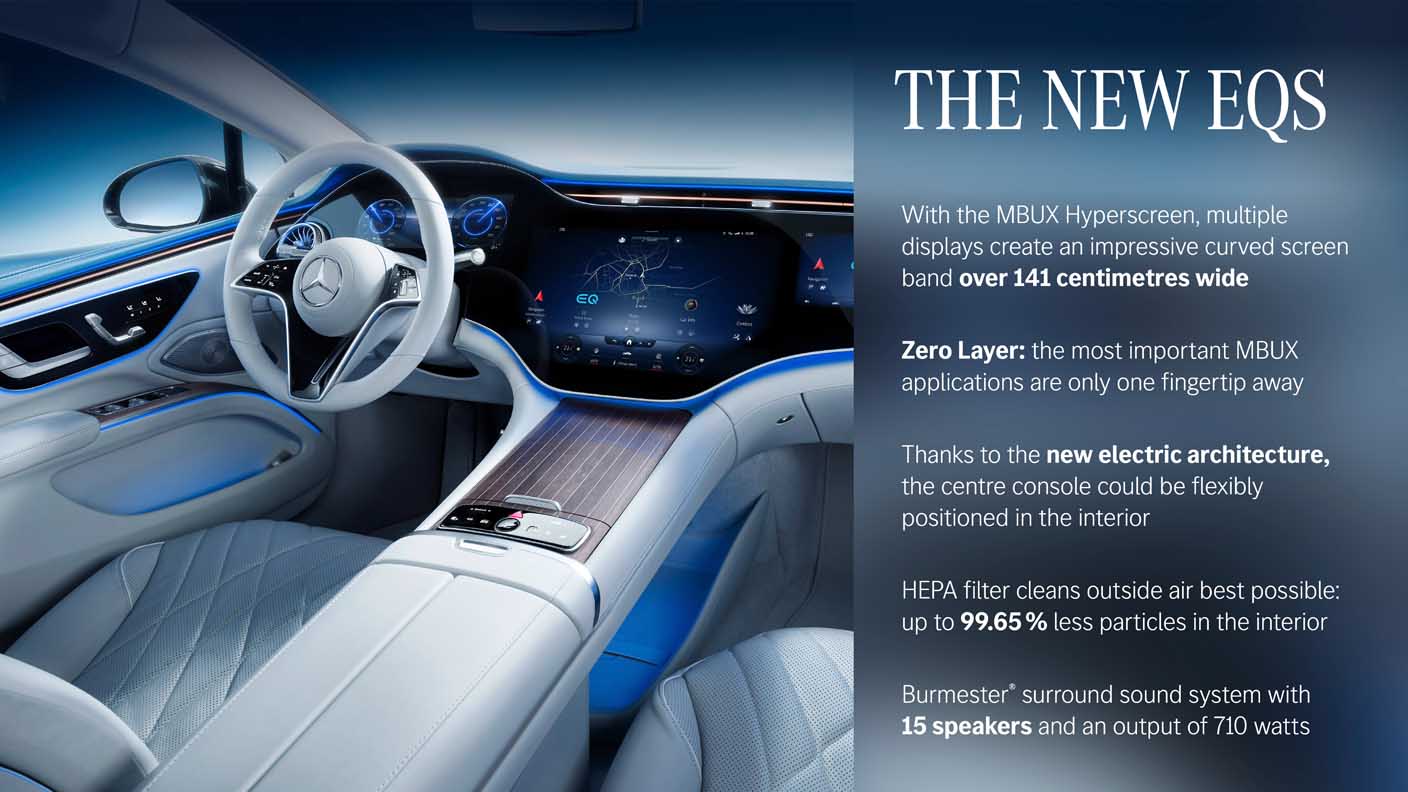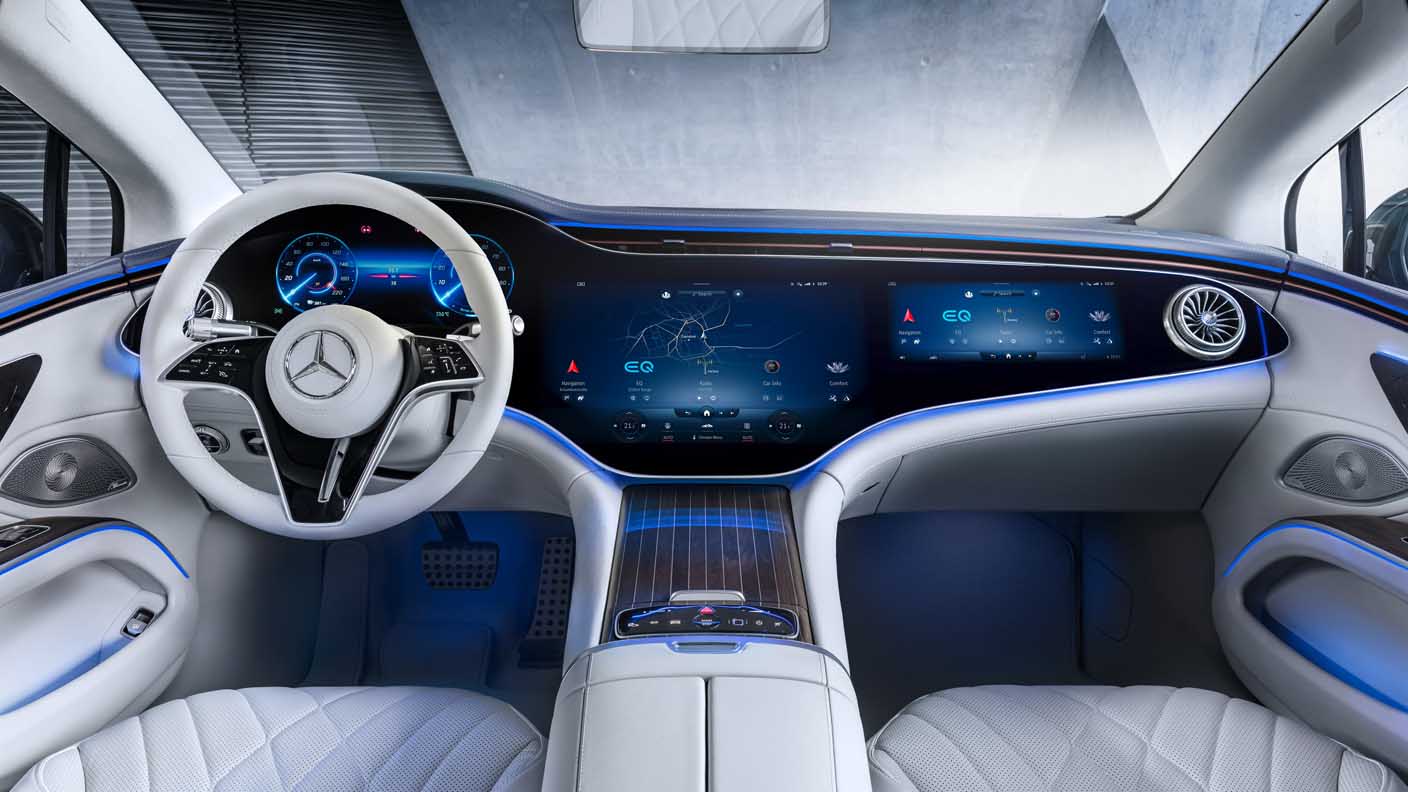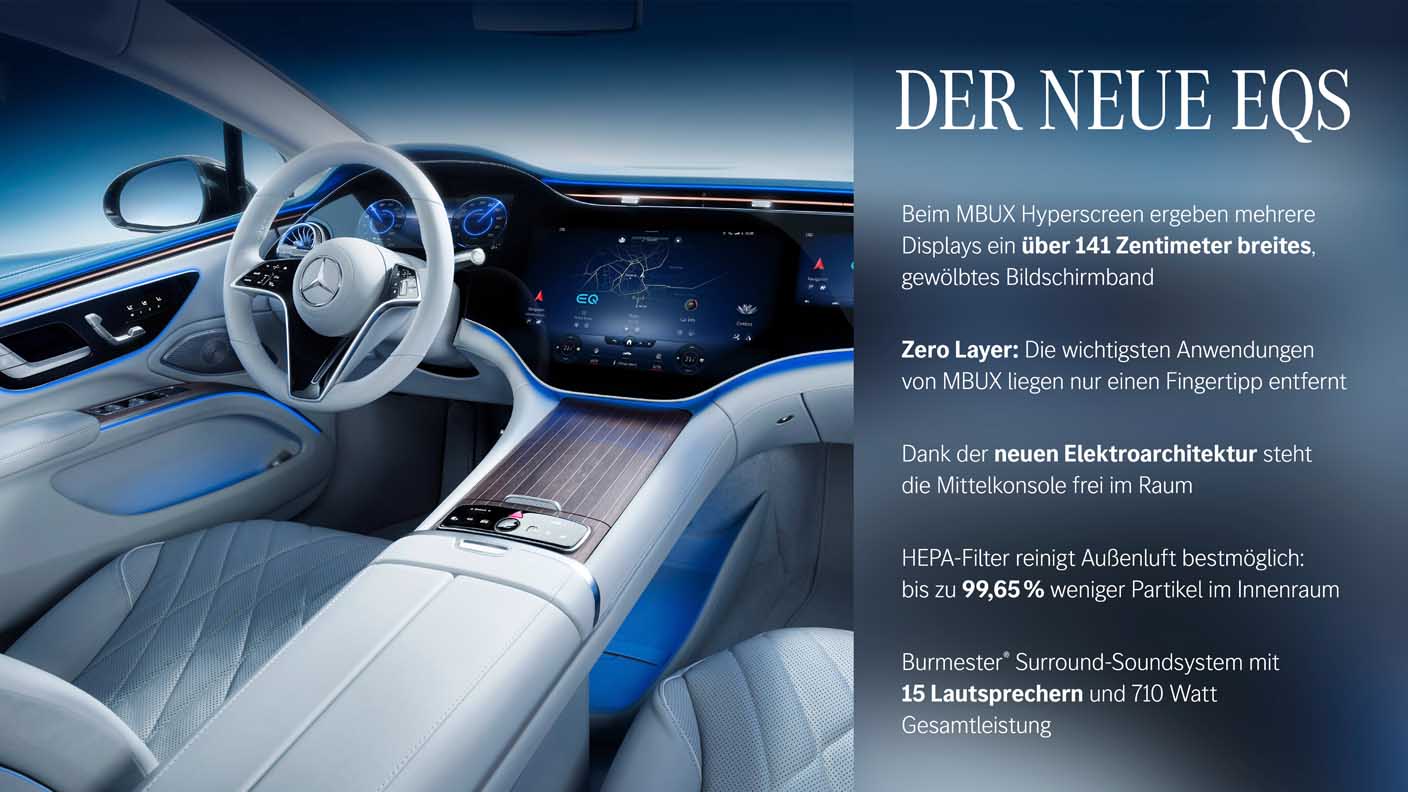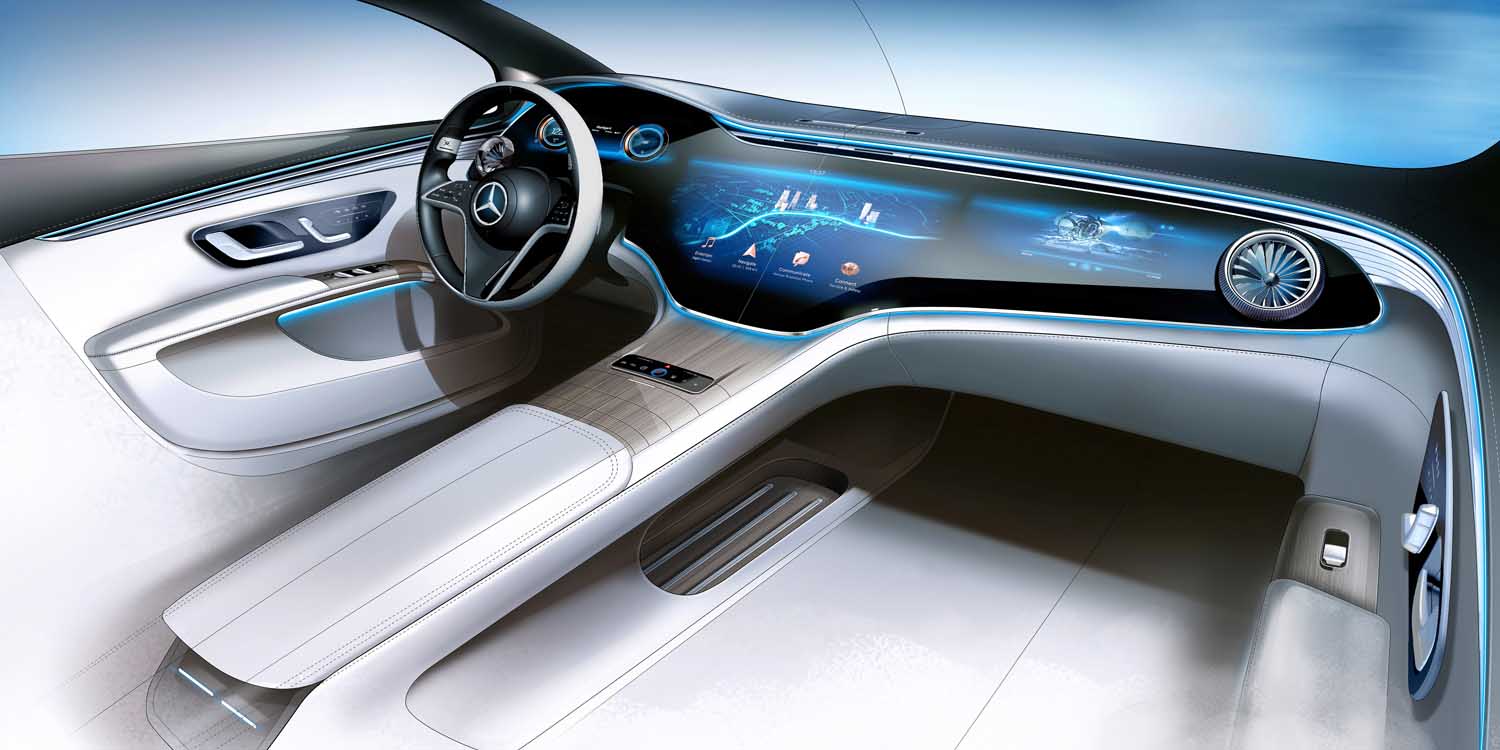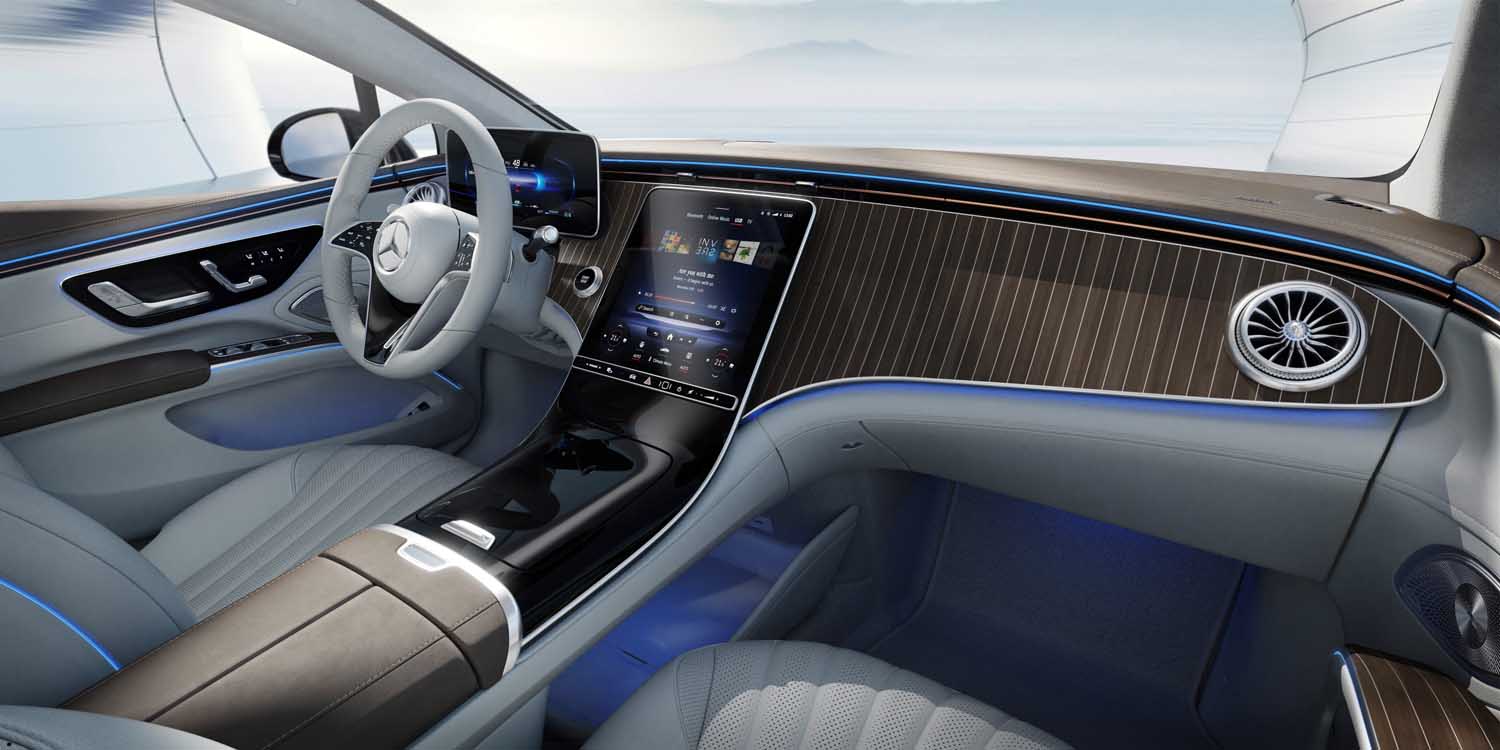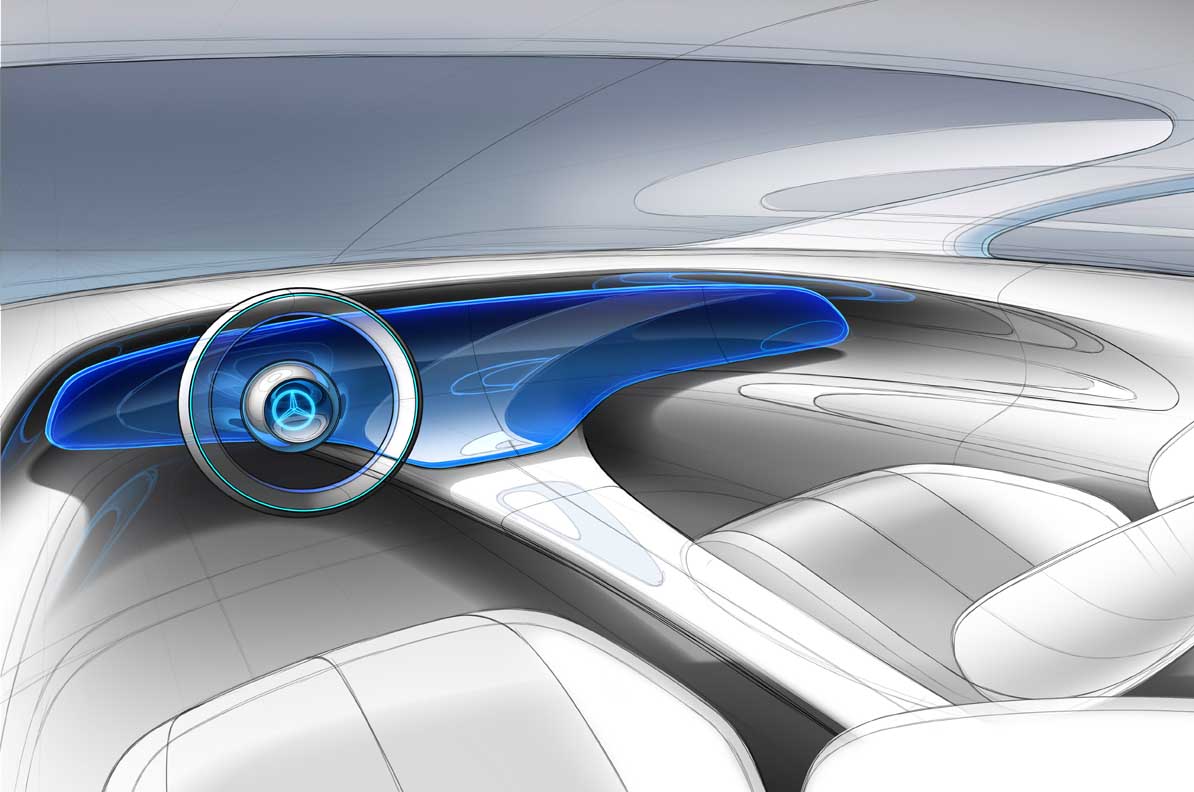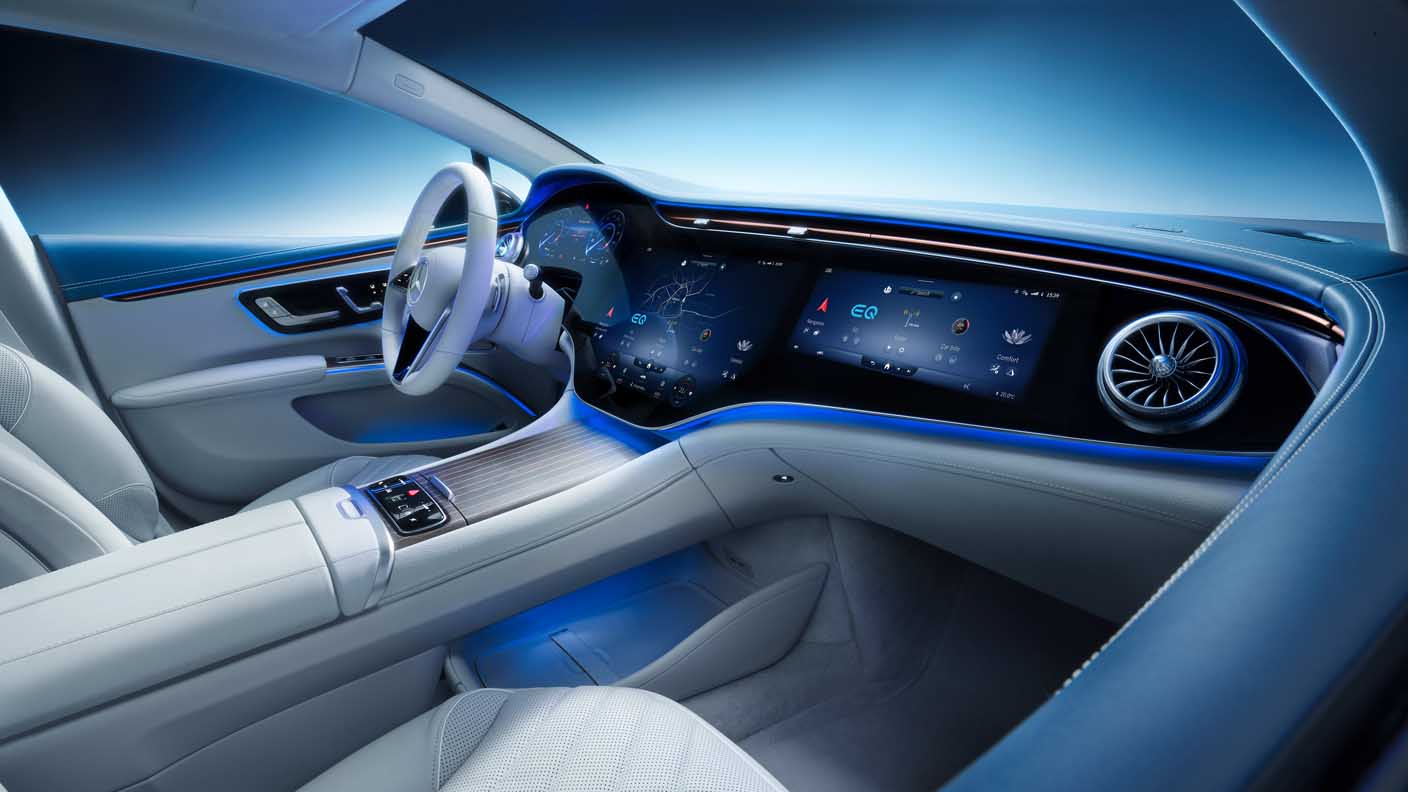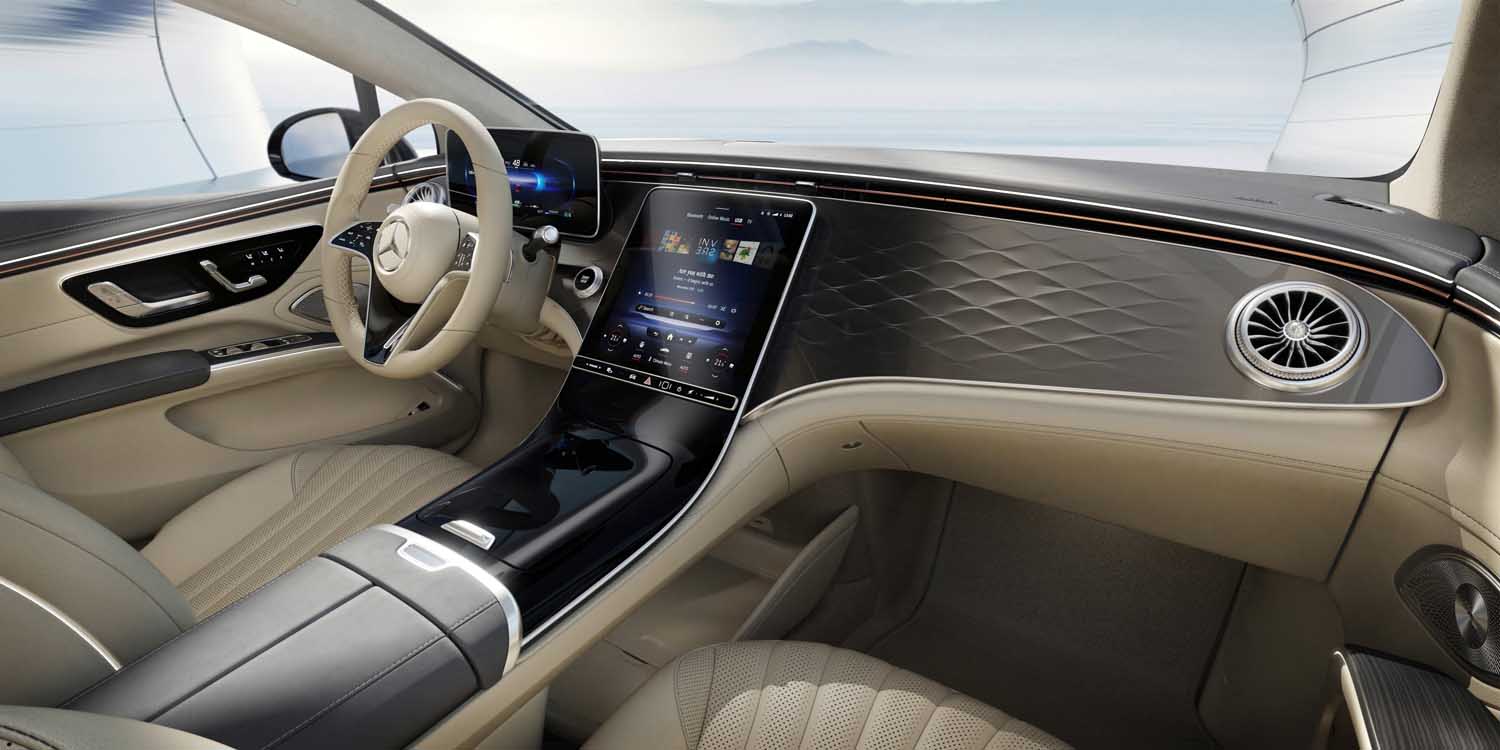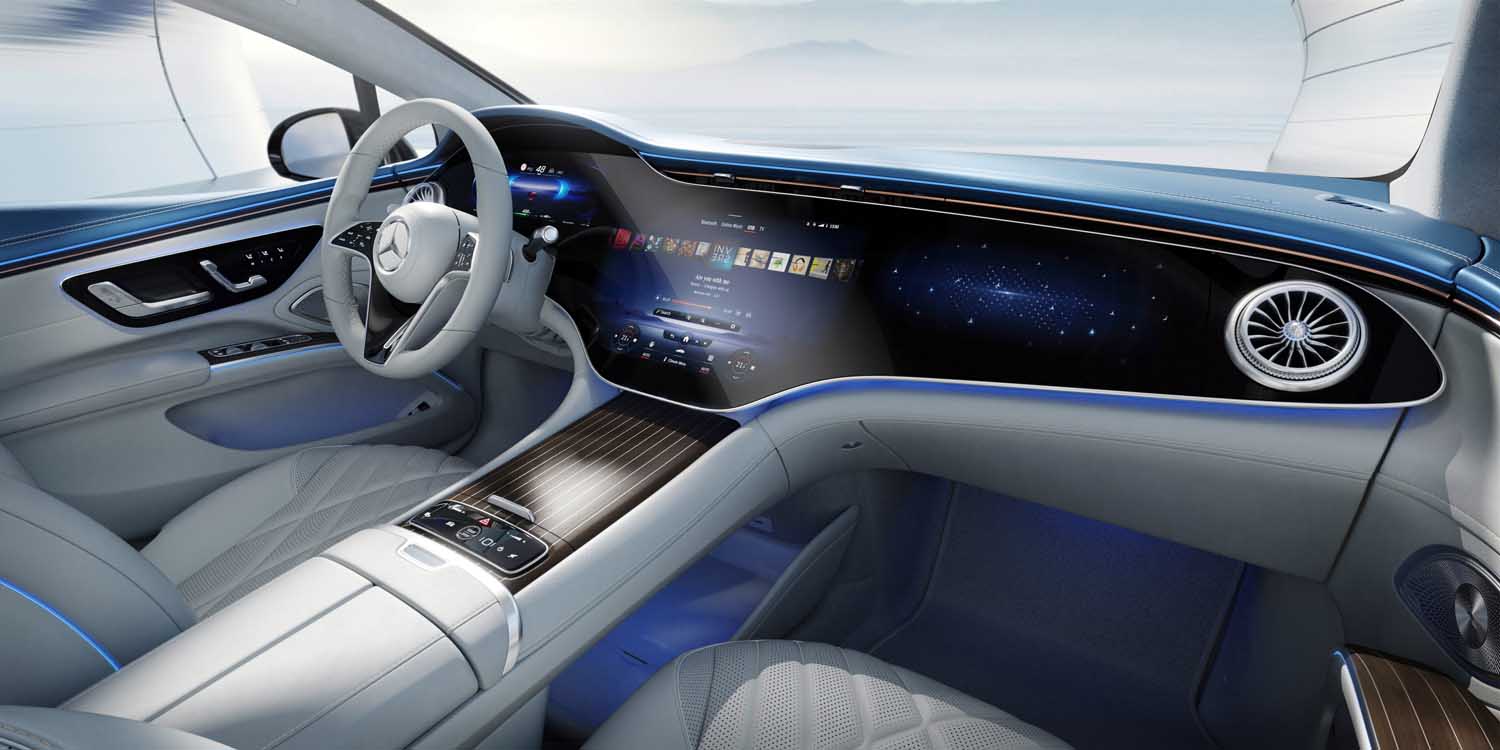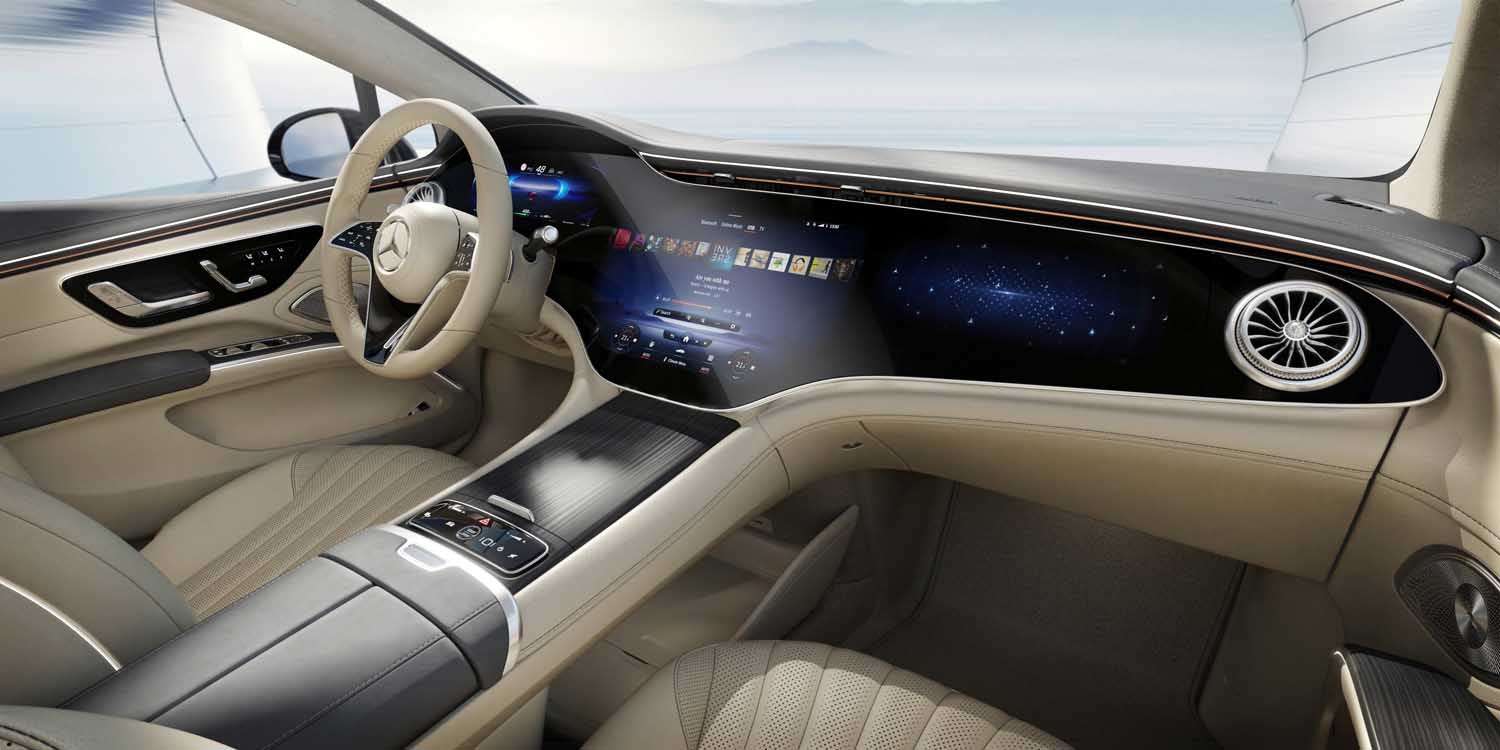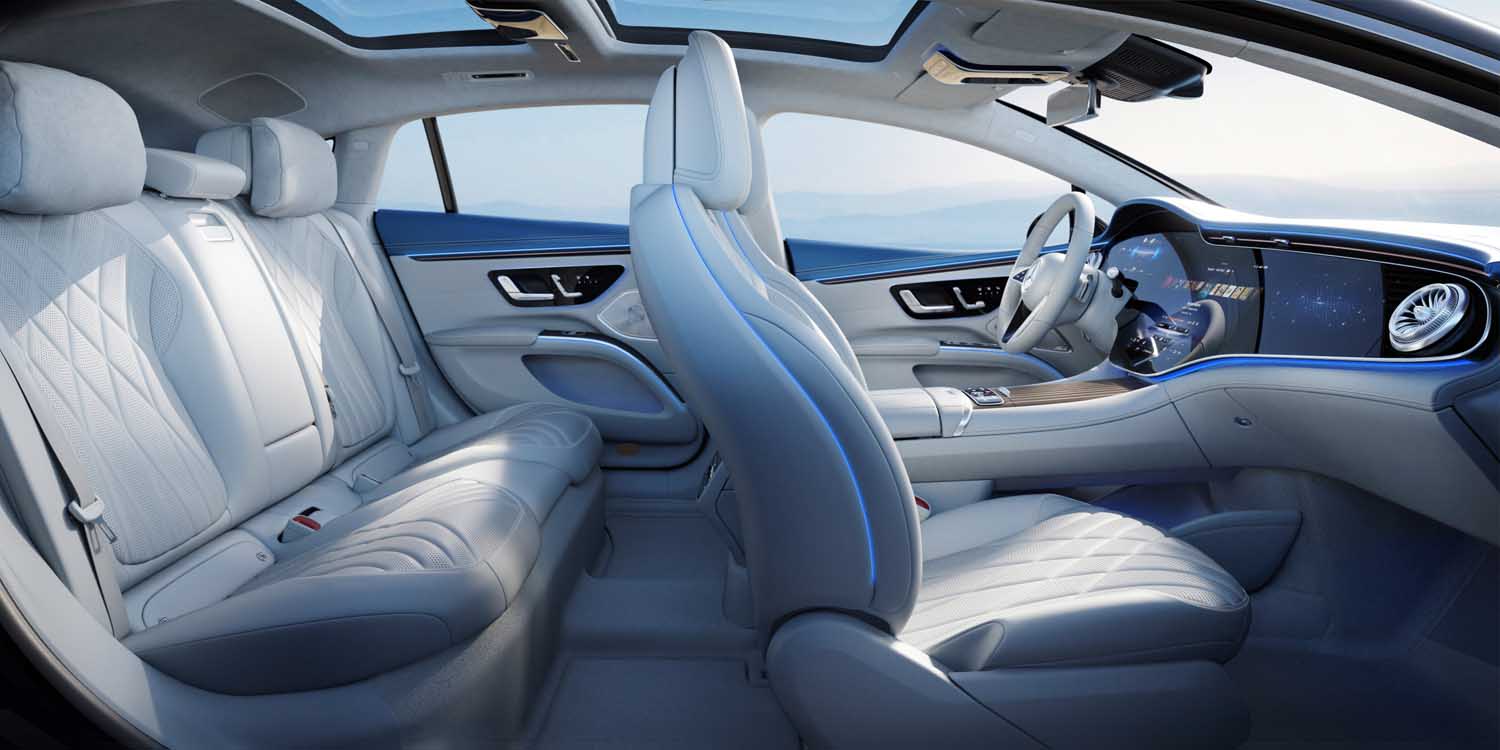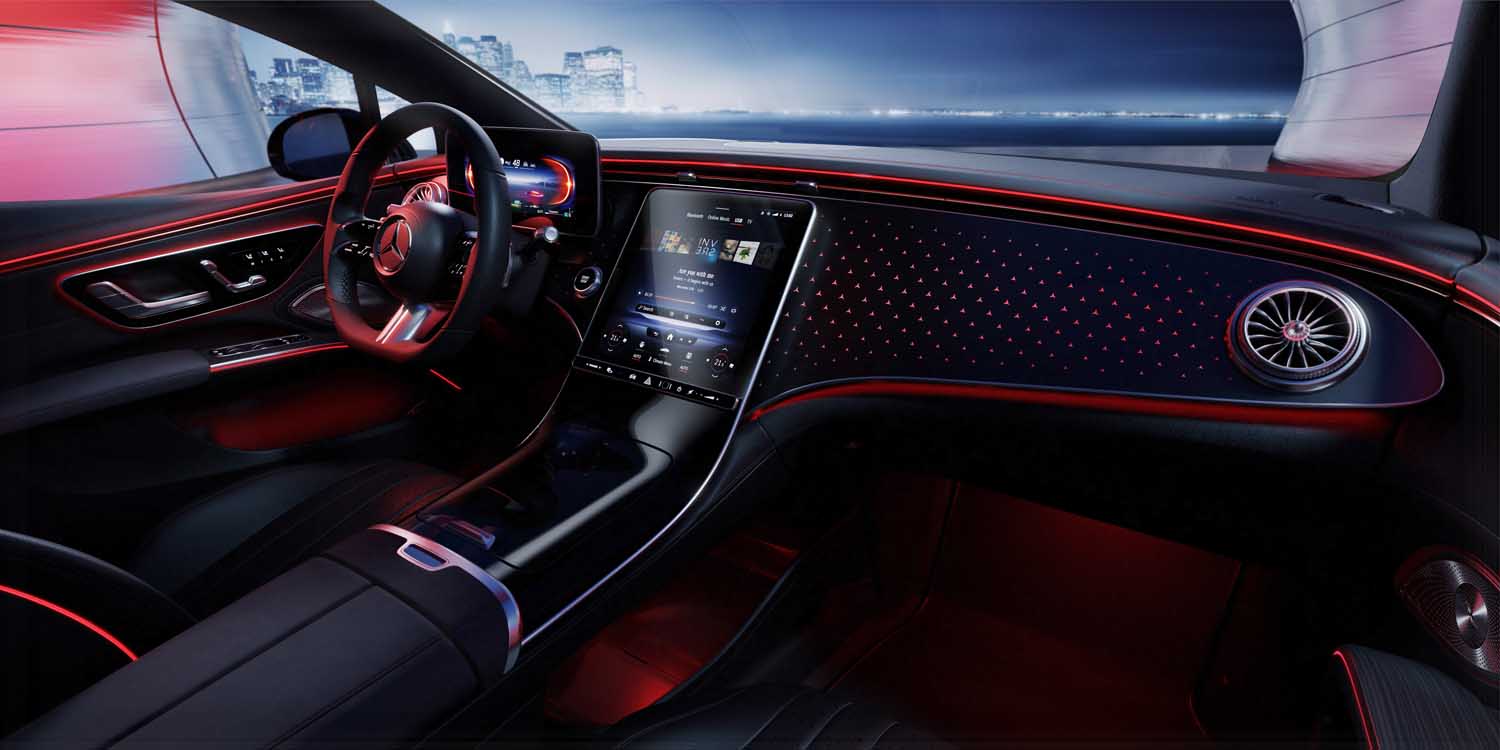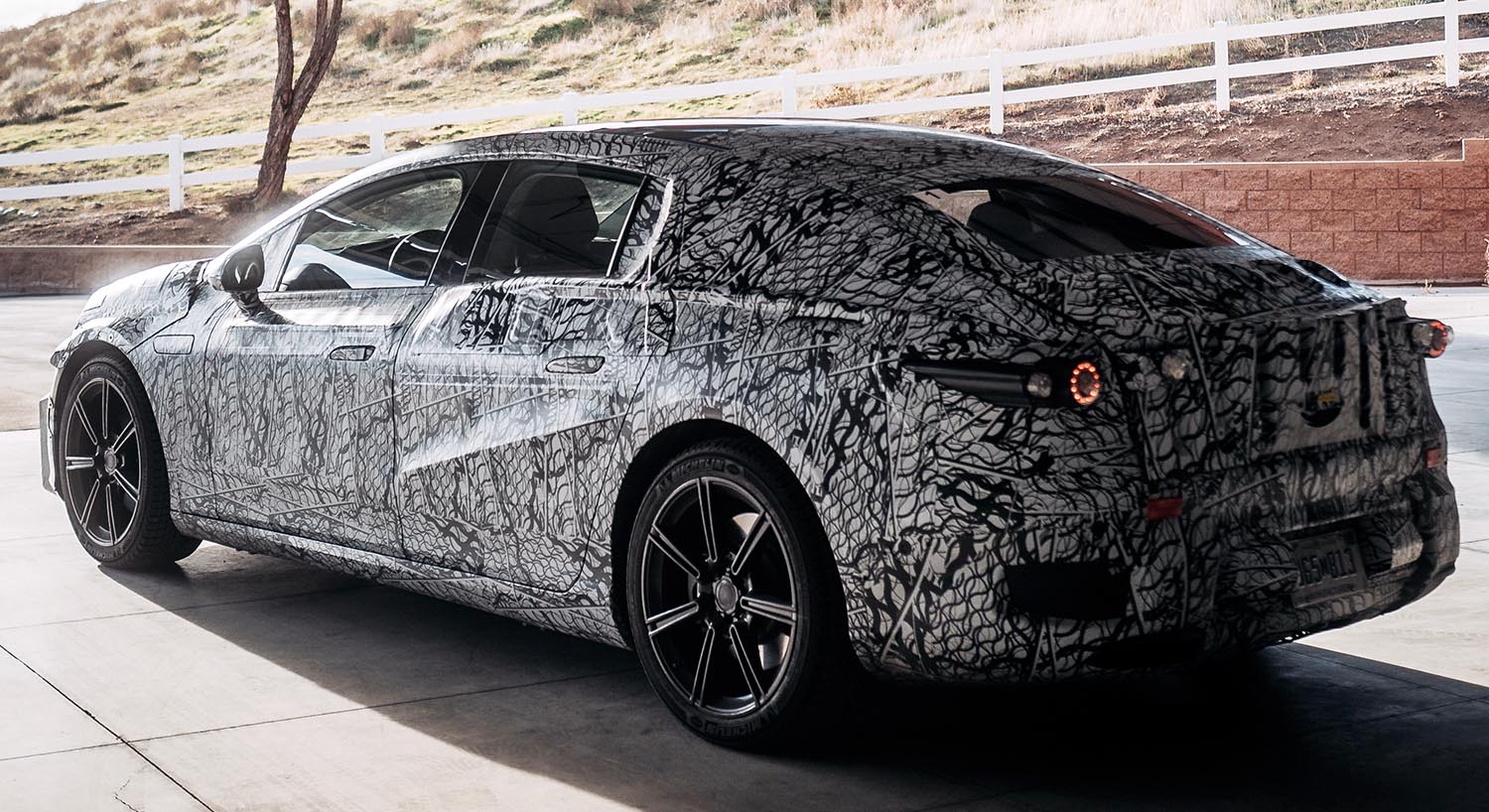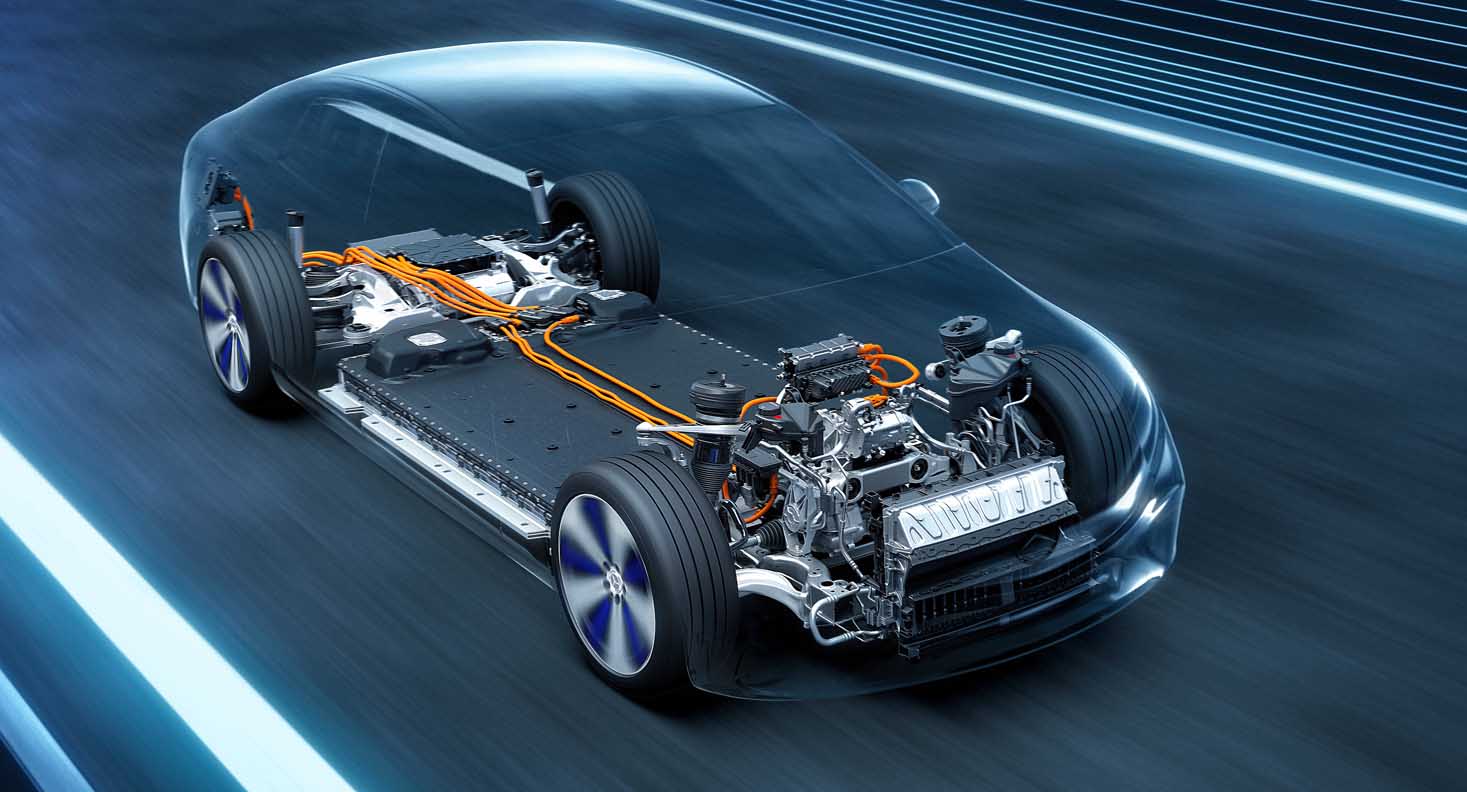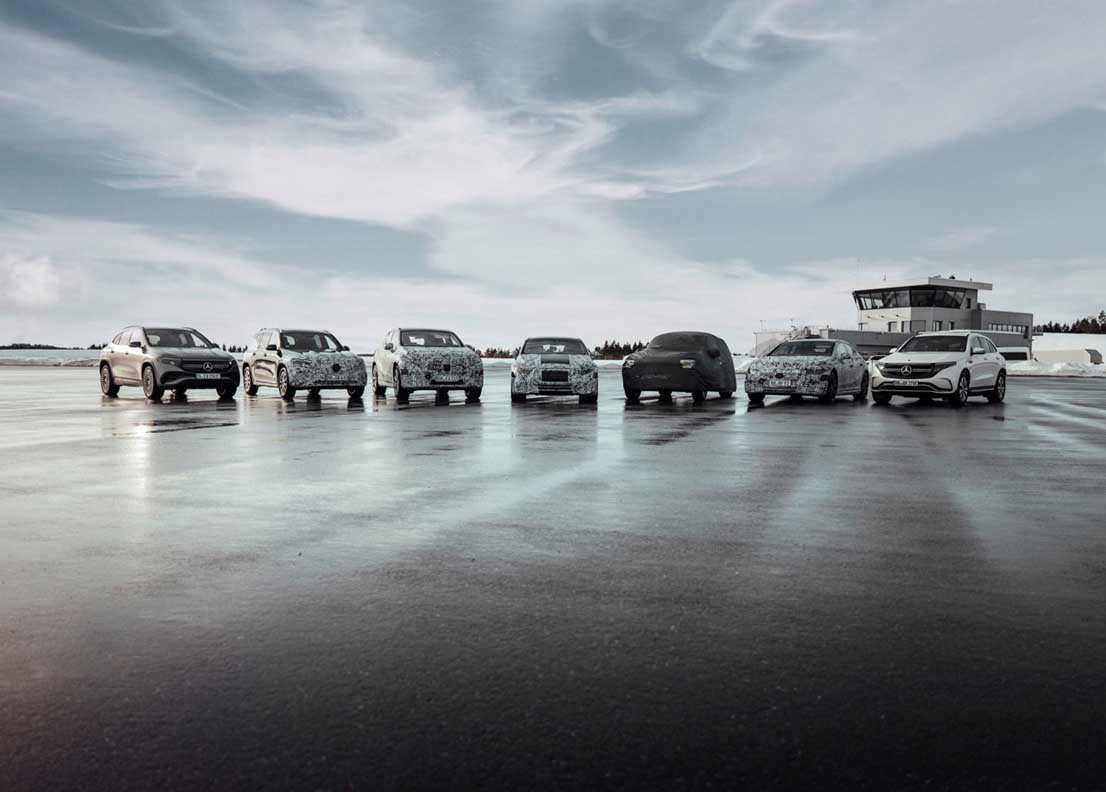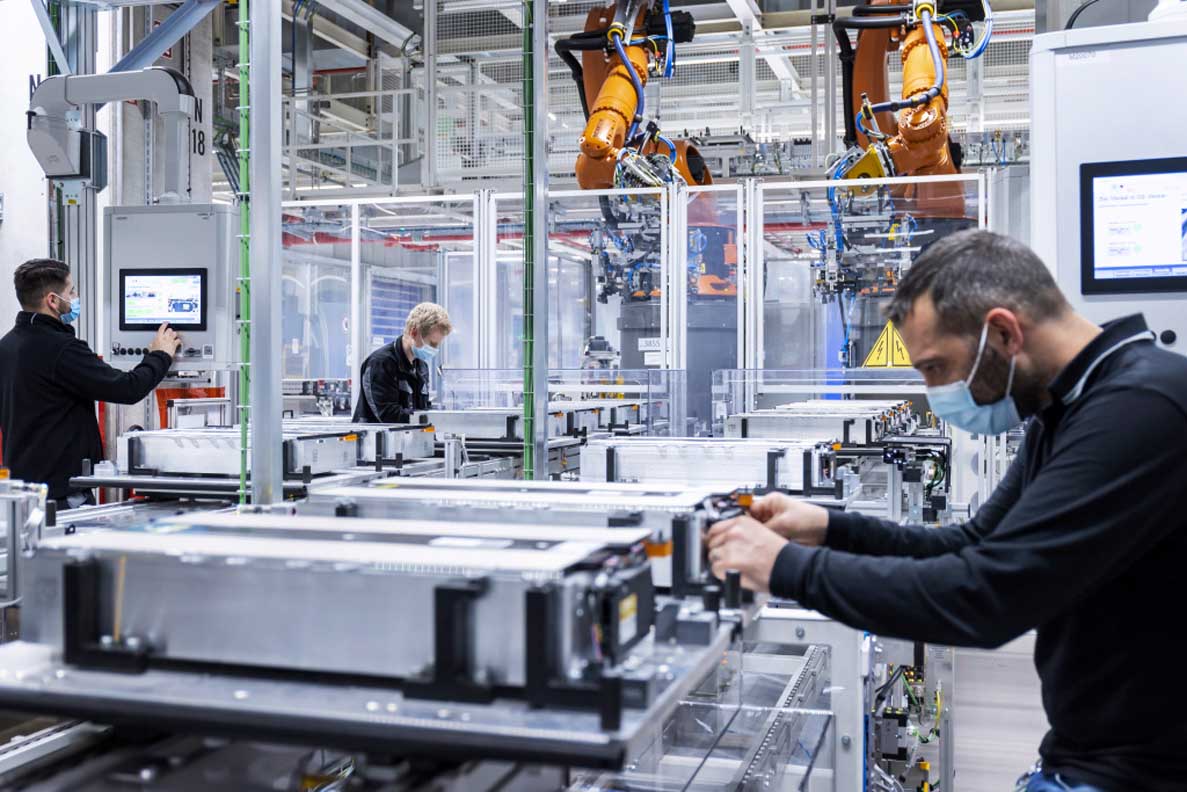
The EQS is the all-electric luxury saloon from Mercedes. With it, Mercedes-EQ is redefining this vehicle segment. The EQS is also the first model to be based on the modular architecture for luxury and executive-class electric vehicles. Fusing technology, design, functionality and connectivity, the EQS delights both drivers and passengers. With a Cd value starting from 0.20 it sets a new aerodynamic benchmark for production vehicles. Supported by artificial intelligence (AI), it makes their everyday lives easier in many areas. The EQS is produced together with the S-Class and the Mercedes-Maybach S-Class on a completely carbon-neutral basis in “Factory 56” at the Sindelfingen plant, Mercedes-Benz’s most modern automotive production facility. The battery systems are produced at the nearby Mercedes-Benz Untertürkheim location in the Hedelfingen plant part. The EQS will be launched in Europe this August.
The EQS can be experienced with almost all the senses. This elevates the all-electric top-of-the-range model to a new dimension in aesthetics and luxury. At the same time, the EQS testifies to the passionate commitment of its developers and designers to electric mobility.
This “Digital Deep Dive Design” presents some of the innovations. Here are the most important ones,
from A for aerodynamics to Z for zero-layer concept:
| Innovation | Description | Customer experience |
| Aerodynamics | A world record. First production car in the world with a Cd value starting from 0.201 | Greater range. |
| ENERGIZING NATURE | New ENERGIZING COMFORT programmes with soothing sounds | Can be relaxing |
| HEPA filter | Elaborate filter system cleans the incoming outside air at its very high filtration level | Inside air almost free of fine dust, minute particles, pollen and unpleasant odours |
| MBUX Hyperscreen | The entire instrument panel is the ultimate widescreen | Progressive luxury at first sight – for both occupants in the front row |
| One-bow design | Bowed lines | Innovative aesthetics |
| Over-the-air updates | Activation of vehicle functions such as additional soundscapes through WLAN technology | EQS remains up-to-date for the life of the vehicle |
| sound experiences | Various soundscapes, including optional driving sound in the interior | Interactive sound experience |
| Zero-layer concept | The key applications pertaining to the situation and context at the top MBUX level in the field of vision. | Even further simplified operation with personalised suggestions; even less distraction for the driver |
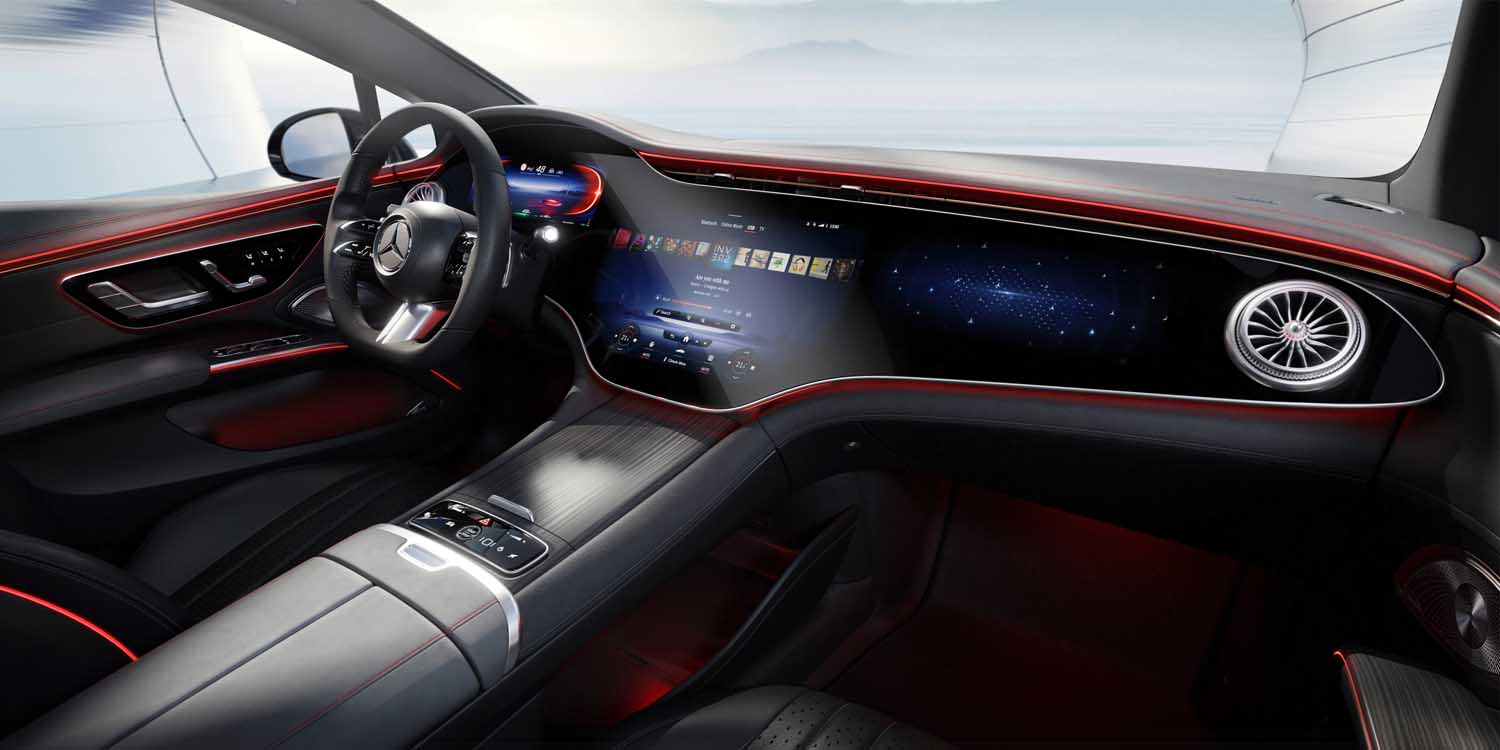
The Mercedes Management on the EQS
“At Mercedes, we are striving for nothing less than leadership in the field of electric mobility and digitisation through an intelligent platform strategy and a software-based approach. The new EQS shows: we are following our own Mercedes path by offering customers a highly efficient, electric and luxurious experience with our electric vehicles.”
Markus Schäfer, Member of the Board of Management of Daimler AG and COO of Mercedes-Benz Cars
“With our EQS, we have created a completely new, future generation of luxury cars. Based on our style of sensual purity, we create desire by combining a beautifully seductive sculpture with the most progressive proportion. Key features such as the ‘one-bow’ design and a holistically integrated, highly reduced and seamless styling gives the EQS its sporty and progressive look. That’s what sets it apart from any other vehicle we have ever created – that’s what makes our EQS so extraordinary.”
Gorden Wagener, Chief Design Officer of Daimler Group
Can be experienced with virtually all human senses
Seeing, hearing, smelling, feeling and tasting, these are the classical human senses. The new EQS appeals to the first four in many ways:
- Visual perception: over 100 million rods and cones are located in the retina of the human eye. These sensory cells enable us to see, for example, the features of the EQS that are revolutionary for the luxury class, such as the cab-forward design or the coupé-like “one-bow” lines with fastback. This clearly distinguishes the EQS from vehicles with combustion engines at first glance and is further emphasised by the Black Panel front and the design of the lights.The designers had the mission and the chance to tread a completely new path in styling the interior. They made use of this freedom: the MBUX Hyperscreen is one of the highlights in the new EQS. The concave screen stretches out in front of the occupants from the left to the right A-pillar like an ocean wave. Besides the sheer size, the high-quality, detailed design also guarantees a “wow” effect. The MBUX Hyperscreen is integrated into the instrument panel in minimalist fashion. Only a thin silver shadow frame, a vent band and a narrow leather frame surround it. The vent band spans across the entire at the top and is very slim at the same time. These extreme proportions, together with the glass wave of the MBUX Hyperscreen, create the avant-garde architecture of the cockpit. The calm and clear design of the door panels borrows from the interior design of modern living spaces. Avant-garde as well as traditional materials and colours give the interior a special atmosphere. Another visual highlight is the head-up display with augmented reality content.
- Auditory perception: people perceive sound waves with their ears. The listening impression of the EQS ranges between comfortable silence and an interactive, sensual sound experience. With a holistic sound production, the sound experts from Mercedes have made the paradigm shift from the combustion engine to the electric car acoustically perceptible. The EQS comes from the factory with two soundscapes: Silver Waves and Vivid Flux. They can be selected or switched off as sound experiences on the central display. Driver and passengers are already greeted acoustically when approaching the vehicle and when getting in. A corresponding aura sound also accompanies exiting and locking the EQS. The optional driving sound, which is reproduced by the speakers of the sound system in the interior, is also within the respective soundscape. The new ENERGIZING NATURE programmes of ENERGIZING COMFORT also offer an impressively realistic listening experience. The soothing sounds called Forest Glade, Sounds of the Sea and Summer Rain were created in cooperation with nature acoustician Gordon Hempton. As with the other ENERGIZING COMFORT programmes, other senses are addressed with lighting moods and images. Streaming services are another alternative to the new type of silence and interactive driving sound in the car: Mercedes-Benz has integrated all the major music streaming services into the MBUX infotainment system with the “Online Music” service.
- Olfactory perception: scents are constantly being introduced when we breathe. Two systems report odours to the brain independently of each other: millions of receptors in the nasal mucosa and the ends of the trigeminal nerve. The EQS has something against unpleasant odours: its large HEPA filter (High Efficiency Particulate Air) not only cleans the outside air very effectively of fine dust, minute particles and pollen. Special activated charcoals in the HEPA filter and the cabin filter also filter out sulphur dioxide and nitrogen oxides as well as odours. Due to their pore structure, they have a very large inner surface area. Around 600 grams of activated charcoal are used in the HEPA filter of the EQS. The adsorption area is equivalent to about 150 football fields.The active fragrancing of the EQS, which is part of the AIR-BALANCE Package, also appeals to the sense of smell. A new fragrance has been composed for the new top-of-the-range electric model: No.6 MOOD Linen – carried by the green note of a fig lying on a piece of linen.
- Haptic perception: the skin is the largest human sensory organ. With its help, we perceive touch and feel, for example, whether things are soft or hard, warm or cold, wet or dry. There is a lot to feel in the interior of the EQS: flowing leather surfaces with intricate seam patterns or dynamic perforation; the modern fine structure NEOTEX, which combines the look of nubuck leather and high-tech neoprene; trim elements made of open-pore real wood or in 3D relief look. The MBUX Hyperscreen’s central and passenger displays also offer haptic feedback. If a finger touches certain points on the touchscreen, the user feels pulses on the smooth surface that give the impression of a mechanical switch. Another operating aid is the so-called force feedback of both displays. Different levels of pressure on the glass change the response. For example, MBUX then jumps to another menu level. Finally, the up to ten different massage programmes of the EQS can be felt not only with individual fingers, but with the whole body. They use the vibration motors in the seats and can also enhance the effect of the relaxing massage with heat based on the hot stone principle. For this purpose, the seat heating is combined with the inflatable air chambers of the multicontour seats.
Able to learn quickly thanks to artificial intelligence (AI)
But the EQS is not only a car that appeals to (almost) all human senses. As an exceptionally intelligent vehicle, it also has many senses itself. Depending on the equipment, up to 350 sensors of various types are used as sensory organs in all parts of the car. They measure distances, speeds and accelerations, lighting conditions, precipitation and temperatures, seat occupancy as well as the driver’s eyelid movements or the passengers’ language. This wealth of information is processed by control units that, controlled by algorithms, make decisions at lightning speed. So they are the brain, so to speak. But a lot of information is only useful if you can do something with it. The new EQS can expand its capabilities based on new experiences, because it is highly capable of learning thanks to artificial intelligence (AI).
Here are some examples of how and where AI is improving the customer experience:
- The optional driving sound is interactive, reacting to a good dozen different parameters such as the position of the accelerator pedal, speed or recuperation. The choice of drive program also influences the driving sound. Intelligent sound design algorithms calculate the sounds in the amplifier of the Burmester® surround sound system in real time, and the loudspeakers reproduce them.
- The ENERGIZING COACH recommends one of the ENERGIZING COMFORT programmes Freshness, Warmth, Vitality or Joy depending on the situation and the individual. If the Mercedes-Benz vivoactive® 3 smartwatch, the Mercedes-Benz Venu® smartwatch or another compatible Garmin® wearable is linked, personal values such as stress level or sleep quality optimise the precision of the recommendation.
- The MBUX system proactively shows the right functions for the user at the right time. The context-sensitive awareness is constantly optimised, both by changes in the surroundings and by user behaviour. The so-called zero layer offers the user dynamic, aggregated content from the entire MBUX system, and thus the associated services, on the uppermost level of the MBUX information architecture. The MBUX Interior Assistant recognises operating requests based on movements and in the EQS does so also in the rear.
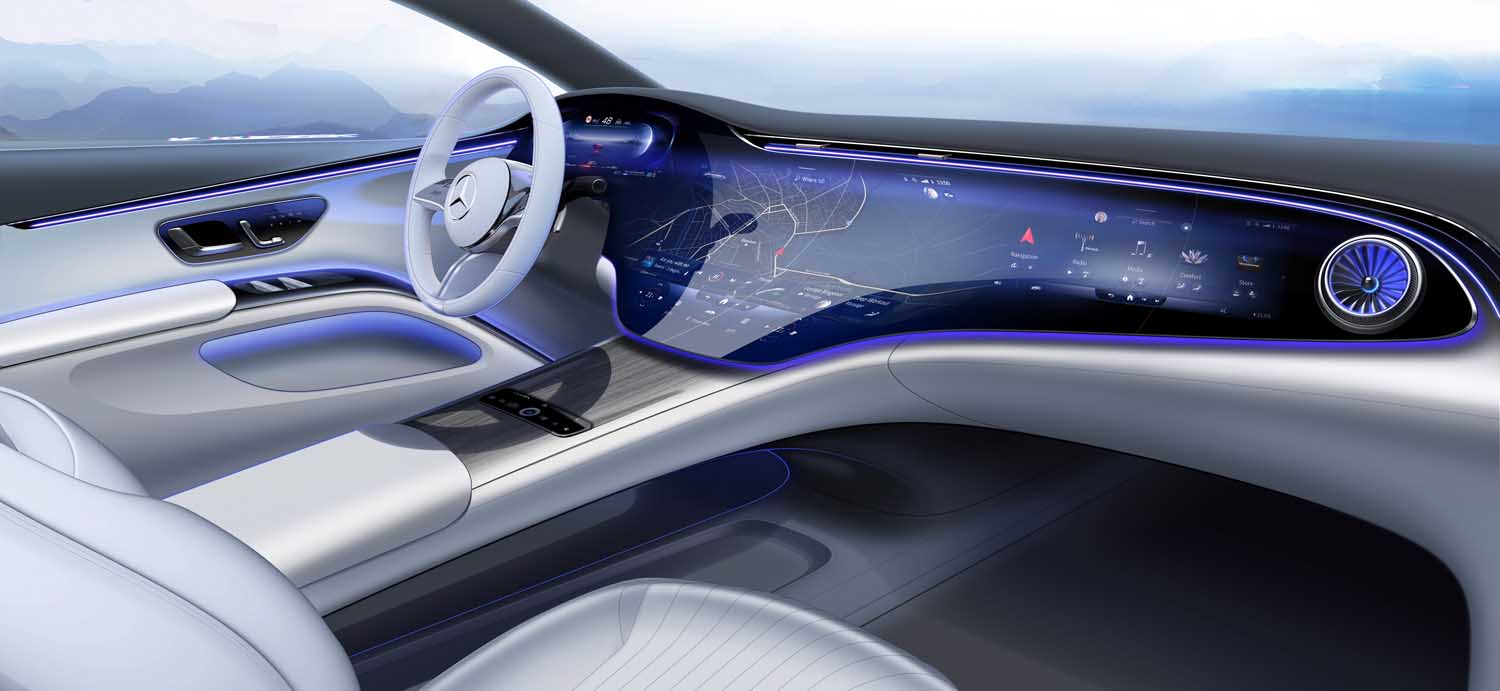
Mercedes-EQ: leadership in electrification and sustainable production
As part of its “Ambition 2039” initiative, Mercedes-Benz is working on offering a carbon-neutral fleet of new vehicles less than 20 years from now. By as early as 2030, the company intends to sell more than half of its cars with electric powertrain (xEV) – this includes all-electric vehicles and plug-in hybrids.
The EQS is produced together with the S-Class and the Mercedes-Maybach S-Class on a completely carbon-neutral basis in “Factory 56” at the Sindelfingen plant, Mercedes-Benz’s most modern automotive production facility. Fully in line with Ambition 2039, this modern automobile plant is a zero-carbon factory – completely carbon-neutral and with considerably reduced energy requirement. Innovative technologies and processes that optimally assist employees with their daily work have been introduced systematically throughout the building.
Local battery production is a major success factor in the strategic electric initiative of Mercedes-Benz AG – and a crucial element when it comes to being able to flexibly and efficiently serve the global demand for electric vehicles. As part of the Mercedes-Benz Drive Systems Campus Untertürkheim (Germany, the Hedelfingen plant is responsible for the production of Mercedes-EQ battery systems for the EQS.
Interesting facts & figures
The new EQS: at a glance
With the MBUX Hyperscreen, multiple displays merge seamlessly to create an impressive curved screen band over 141 centimetres wide. The area perceived by the occupants measures 2432.11 sq. cm.
The large glass covering the MBUX Hyperscreen is curved in three dimensions in a moulding process at temperatures of approx. 650°C. This process allows a distortion-free view of the display unit across the entire of the vehicle, irrespective of the radius of the glass cover.
Depending on the equipment, up to 350 sensors monitor the functions of the EQS or peer into the vehicle’s surroundings. And that’s not even counting the antennas. The sensors measure, for example, distances, speeds and accelerations, lighting conditions, precipitation and temperatures, the occupancy of seats as well as the driver’s eyelid movements or the passengers’ language.
The optional driving sound of the EQS is interactive and reacts to a good dozen different parameters such as the position of the accelerator pedal, speed or recuperation.
No.6 MOOD Linen is the name of the fragrance composed especially for the EQS. It bears the number 6 because the first electric cars were added to the model range in 1906 with the “Mercédès Electrique” vehicles.
More than 40 new inventions have found their way into EQS. In addition, 20 design applications protect the extraordinary design of the electric luxury sedan.
To get to the most important applications of MBUX, the user has to scroll through 0 menu levels. That’s why it’s called a zero layer.
The display area of the optionally available larger head-up display corresponds to a screen with a diagonal of 77 inches. The imaging unit consists of a high-resolution matrix of 1.3 million individual mirrors.
The “Mercedes-Benz pattern” is used in several places in the EQS, for example, in the exterior as a special variant of the Black Panel front or in a light-alloy wheel design. In the interior, the Mercedes-Benz pattern can be found in the backlit trim elements with laser-cut or on the passenger display as a digital decorative image. It is an abstracted, three-dimensional star pattern based on an early trademark of the Daimler Motorengesellschaft (DMG), which was entered in the trademark registry on 9 February 1911.
The HEPA filter (High Efficiency Particulate Air) as part of the optional equipment ENERGIZING AIR CONTROL Plus with a volume of 9.82 dm³ cleans the incoming outside air at its very high filtration level. Over 99.65 percent of particles of all sizes are eliminated. Around 600 grams of activated charcoal are used to neutralise odours. The adsorption area is equivalent to about 150 football fields.
For haptic feedback during operation, a total of 12 actuators are located under the touchscreen surfaces of the MBUX Hyperscreen. If a finger touches certain spots there, they trigger a tangible vibration in the cover plate.
The Burmester® surround sound system in the EQS comprises 15 speakers with a total output of 710 watts and produces an unusually expressive, natural sound – the Burmester “feel-good sound”.
A coating on the cover glass simplifies cleaning of the MBUX Hyperscreen. The curved glass itself consists of particularly scratch-resistant aluminium silicate.
The EQS is the first production car with a Cd value starting from 0.20. It thus makes use of the advantages of the purpose design.
8 CPU cores, 24 GB RAM and 46.4 GB per second RAM memory band are some of the MBUX technical data.
The brightness of the MBUX Hyperscreen is adjusted to the ambient conditions using the measurement data from 1 multifunction camera and 1 additional light sensor.
With up to seven profiles, the display area of the MBUX Hyperscreen for the front passenger can be individualised.
“Hey Mercedes” supports 27 languages with Natural Language Understanding (NLU).
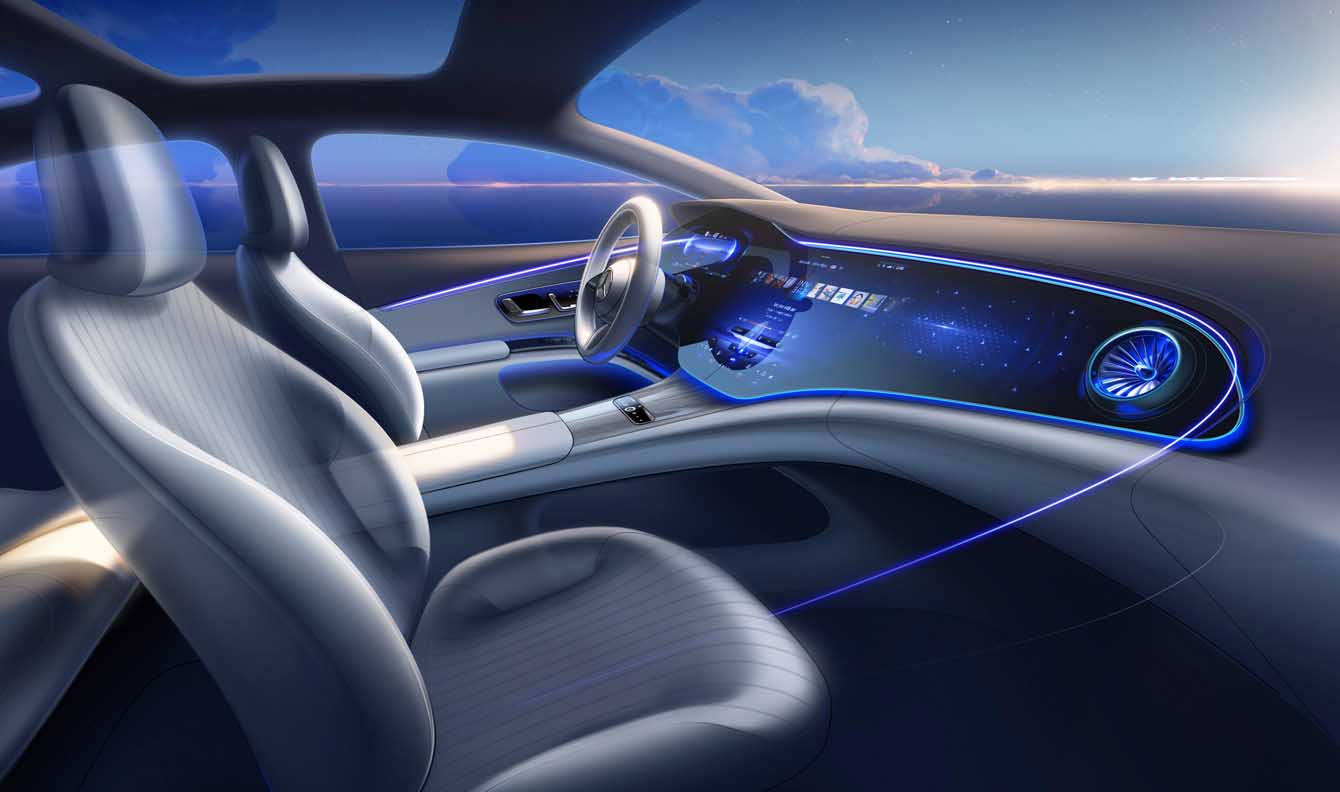
Embarking on the new era of purpose design
The new EQS: design concept (exterior)
Although the EQS is a close relative of the new S-Class, it is built on an all-electric architecture. This completely new concept made a rigorous Purpose Design possible: with its one-bow lines and cab-forward design with fastback, the EQS is clearly distinguishable from vehicles with combustion engines even at first glance. This is further emphasised by the Black Panel front and the design of the front and rear lights. Highest standards on function and aerodynamics go hand in hand with innovative aesthetics. The design philosophy of Sensual Purity, combined with Progressive Luxury, is reflected in generously sculpted surfaces, reduced joints and seamless transitions (seamless design).
Here are the most important keywords about the exterior design of the EQS:
Purpose design: electric cars can either be based on an existing (combustion engine) platform (“conversion design”) or, like the EQS, on an all-electric architecture (“purpose design”). This complete and consistent new concept allows freedom in the arrangement of the components and a radically different design. This leads to advantages in packaging and ergonomics for the EQS. The purpose design with smooth underbody and mostly closed radiator shutter as well as the favourable basic shape were a good starting point for the flow optimisation. With a lot of meticulous detail work, the aerodynamicists, in close cooperation with the designers, were able to achieve the new best Cd value starting from 0.20.
One-bow design: the roof line above the passenger compartment, the so-called greenhouse, is as taut as a bow (“one bow”) in the EQS. A coupé-like silhouette is created in concert with the sportily low and slim front. This is underlined by the frameless doors and a high, curved beltline as an independent design element.
Cab-forward design (“cab placed in front”): The far-forward base of the A-pillar and the C-pillar at the rear create space in the EQS for a generously dimensioned passenger compartment. The overhangs and the front end are short, the rear is smoothly rounded.
Seamless design: Body creases have had their day at Mercedes-Benz. With reduced lines, precise gaps and flowing transitions, the designers have realised the new purism in the EQS in superior fashion. An exemplary element is the front-end design: the front bonnet overlaps the wings. This also reduces the number of visible panel gaps.
Black Panel front: the deep black surface of the grille (“Black Panel”) defines the striking face of the EQS. The Black Panel unit at the front is a design feature of the Mercedes-EQ model family.
Mercedes-Benz pattern: abstracted, three-dimensional star pattern based on the original three-pointed star, the early trademark of Daimler Motorengesellschaft (DMG). The company had applied for a utility model for a three-pointed star in 1909; it was entered in the trademark registry on 9 February 1911. The three-pointed star was used immediately and after a short time was already one of the best-known trademarks in the world. The star first received a wreath in 1916. The pattern is used in several places in the EQS, for example, in the exterior as a special variant of the Black Panel front or in a light-alloy wheel design. In the interior, the Mercedes-Benz pattern can be found in the backlit trim elements with laser-cut or on the passenger display as a digital decorative image.
Light design: the headlights have a striking daytime running light signet with three light dots and are connected to each other via a light band. This is just as defining for the EQ family as the lights at the rear: the rear lights with inner workings in the form of a curved 3D helix are also connected by a light band.
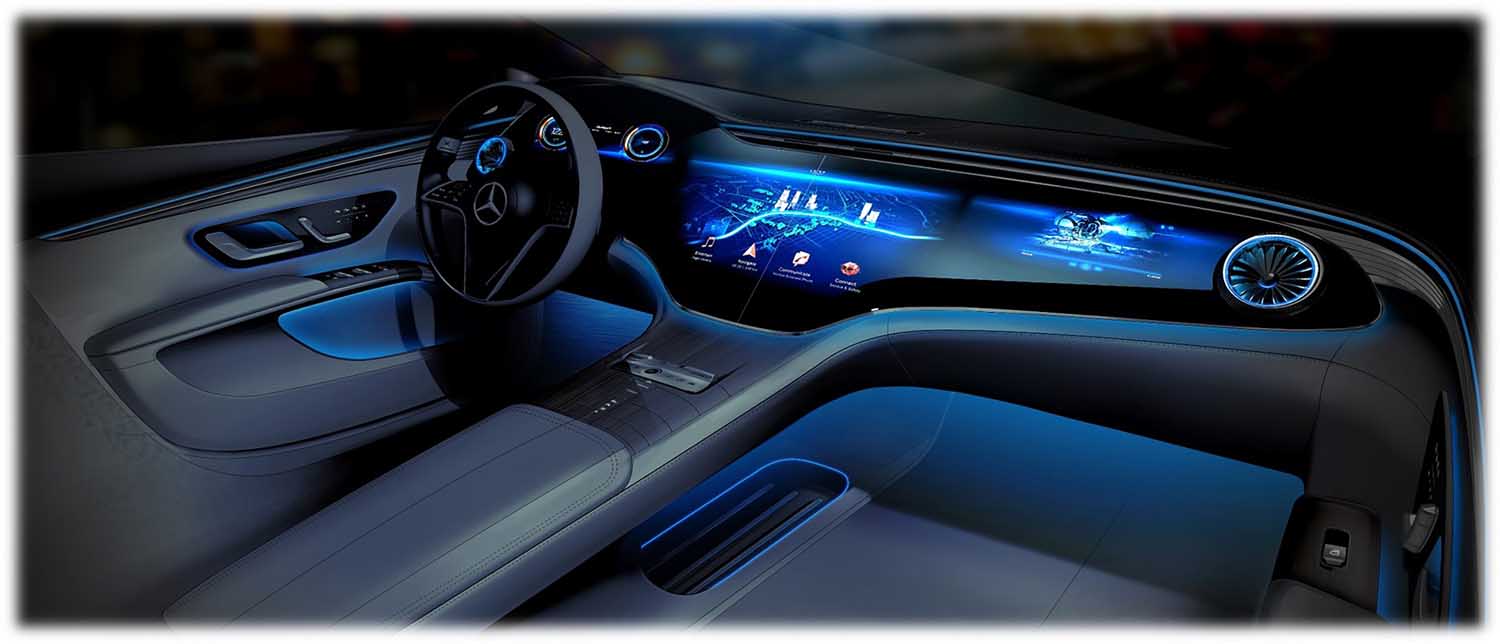
Consistent digitisation and borrowings from interior design
The new EQS: interior design
The EQS is the luxurious and avant-garde top-of-the-range model from Mercedes-EQ. With this completely new type of vehicle, the designers had the mission and the opportunity to take a completely new approach to the interior design as well. They made use of this freedom and, in addition to the MBUX Hyperscreen, relied on consistent digitisation for many other elements.
The EQS is the first Mercedes-EQ to be based on an all-electric platform. For the designers, this went hand in hand with the vision of consistent digitisation of the interior. The optional MBUX Hyperscreen impressively implements this vision: the entire instrument panel is one ultimate widescreen. This determines the aesthetics of the entire cockpit and interior. The real glass appears to drape itself in three dimensions over the entire of the vehicle like a wave – a unique feature in automotive construction to date.
The high-resolution screens merge seemingly seamlessly under the shared glass cover. The graphic appearance of their MBUX content is tailored to each other. The MBUX Hyperscreen is integrated into the instrument panel in minimalist fashion. The MBUX Hyperscreen is surrounded only by a thin silver shadow frame, a vent band and a narrow leather frame, reminiscent of the lower volume body of classic instrument panels.
The vent band spans across the entire at the top and is very slim at the same time. These extreme proportions, together with the glass wave of the MBUX Hyperscreen, create the avant-garde architecture of the cockpit. For further details on the MBUX Hyperscreen, see separate chapters.
The dominant outer vents have a turbine design. They deliberately play on the theme of hyperanalogue through the contrast between high-tech precision mechanics and digital, glass display world. The intricately designed turbine blades distribute the airflow efficiently.
The front section of the centre console joins the instrument panel and stands freely in space. It is a visual reference to the new drive architecture – due to the electric powertrain, no transmission tunnel is necessary. Flowing leather surfaces with intricate seam patterns create a lot of storage space in combination with a large cover made of real wood. The visual impression is both modern and luxurious.
The base model without MBUX Hyperscreen has a slightly different centre console. There is a soft armrest in the rear section. It is first visually interrupted before being transitioned into the floating central display.
The design of the door panels borrows from the interior design of modern living spaces. Doors and their centre panels emerge from behind the MBUX Hyperscreen to span the space. A surface-mounted modular body floats like a sideboard in front of the door panel. It accommodates all necessary door elements such as armrest, door module, pull handle and map pocket. Circular ambient lighting completes this floating, avant-garde aesthetic in the dark.
The Electric Art design and equipment line includes the comfort seats. Despite their simplicity of design, they captivate with their sculptural beauty. Wrap-around surfaces in the side bolsters create the body support and stand in stark contrast to the seat centre panel. It has a sophisticated seam pattern similar to a fan palm.
In combination with the AMG Line interior, the EQS is fitted with the sports seats. They are characterised by a slim and monolithic shape. The seat surfaces are designed in such a way that they give the impression of draped-on leather blankets. The technical term is “layering”.
Common features of the seats are the dynamic graphic patterns with highly elaborate, positioned perforations. Here, too, you will find the typical Mercedes-EQ combination of the highest standards in materials, ambience and workmanship as well as state-of-the-art technology.
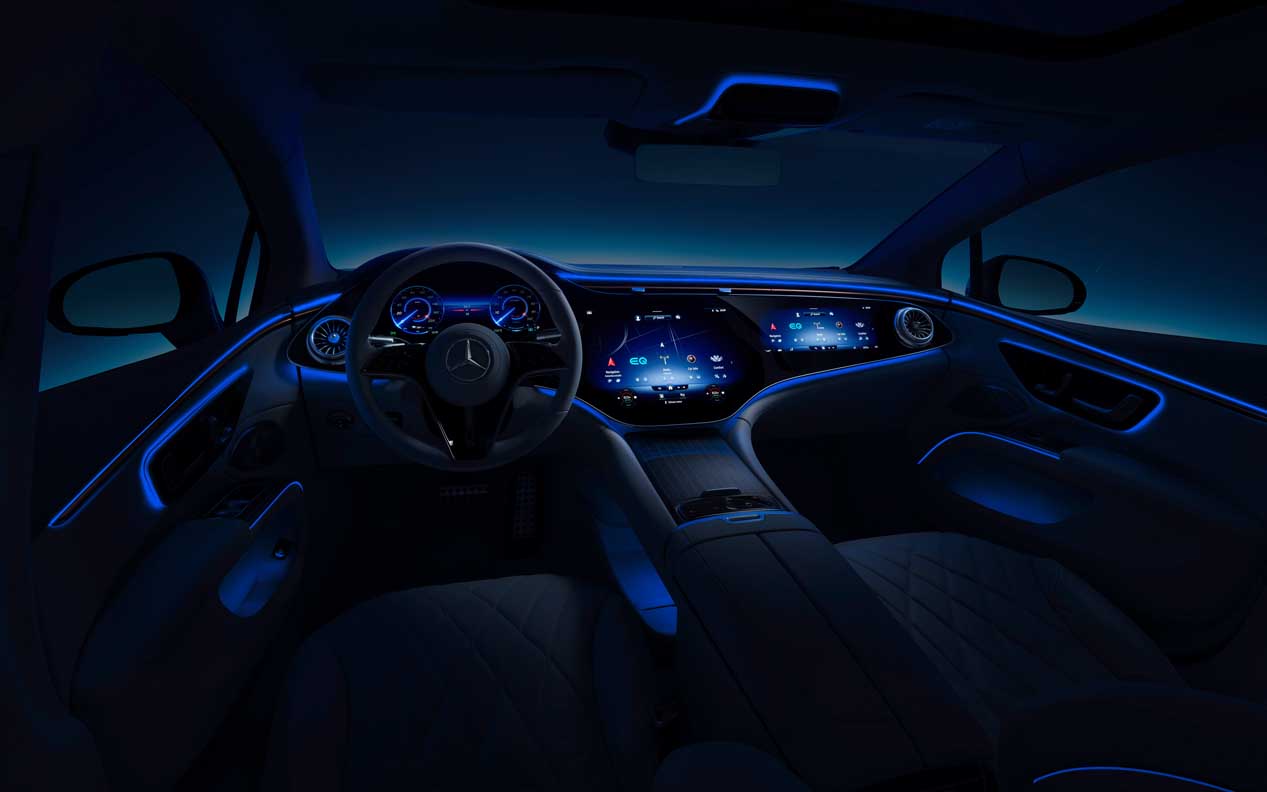
Colour & trim: avant-garde and tradition for a special ambience
Avant-garde as well as traditional materials and colours give the interior a special atmosphere.
The modern delicate structure NEOTEX combines the look of nubuck leather and high-tech neoprene. Microcloud is found on the instrument panel, the armrest and the seats of the Electric Art Line.
Eight coordinated colour combinations in the interior emphasise the generous feeling of space. The EQS is immersed in a progressive and luxurious colour world of warm and cool tones. Colours such as balao brown-neva grey and space grey-macchiato add the finishing touches to the soft and emotive design. The colour rosé gold, derived and evolved from the electric coil, emphasises the design of the vent band and is used as a contrasting colour.
The shape of both seats is outlined by illuminated piping. This creates a unique night-time ambience. The innovative trim elements make a decisive contribution to the aesthetics in the EQS. Two examples: the anthracite 3D relief-look trim elements feature tiny metal pigments. The different lighting situations in the vehicle subtly change the appearance and create a subtle value appeal.
The laser-cut trim elements backlit with Mercedes-Benz pattern also create a special ambience. The star pattern is lasered into the plastic trim and is adaptively backlit. Wood trim elements are also available, for example, anthracite open-pore line-structure lime wood or open-pore walnut ship’s deck wood.
A special welcome & goodbye scenario has been developed for the Mercedes-EQ models, which is also coordinated with the ambient lighting.
UX design: multiple display styles and modes to choose from
The functional content and operating structure correspond to the S-Class, but have been adapted to electric motoring. Visually, all graphics are designed in a new colour world of blue/orange throughout. The classic cockpit display of the two round dials has been reinterpreted with a digital laser sword in a glass lens. All content relevant to driving can be accessed between the round dials.
The “sporty” display from the S-Class has been converted into a three-dimensional performance bar and emotively and impressively conveys the respective driving status (Drive, Accelerate, Charge). The central object here is a “G-force puck”, which dynamically moves freely in space in line with the acceleration forces.
The appearance of the screens can be individualised with three display styles (discreet, sporty, classic) and three modes (Navigation, Assistance, Service).
For a very calm interior impression, the discreet mode familiar from the S-Class has been adapted. In the EQS, the content of the displays is reduced as much as possible and coordinated with the colour change of the ambient lighting in seven screen colour worlds. In “Assistance” mode, important events such as lane changes or target distance control as well as the infrastructure and detected other road users (cars, motorbikes, trucks) are displayed.
Head-up displays are available in two sizes. They contribute to relaxed driving because the driver does not need to look away from the road. The large augmented head-up display is the highlight here, as it shows relevant information and actions three-dimensionally in the actual driving situation and environment.
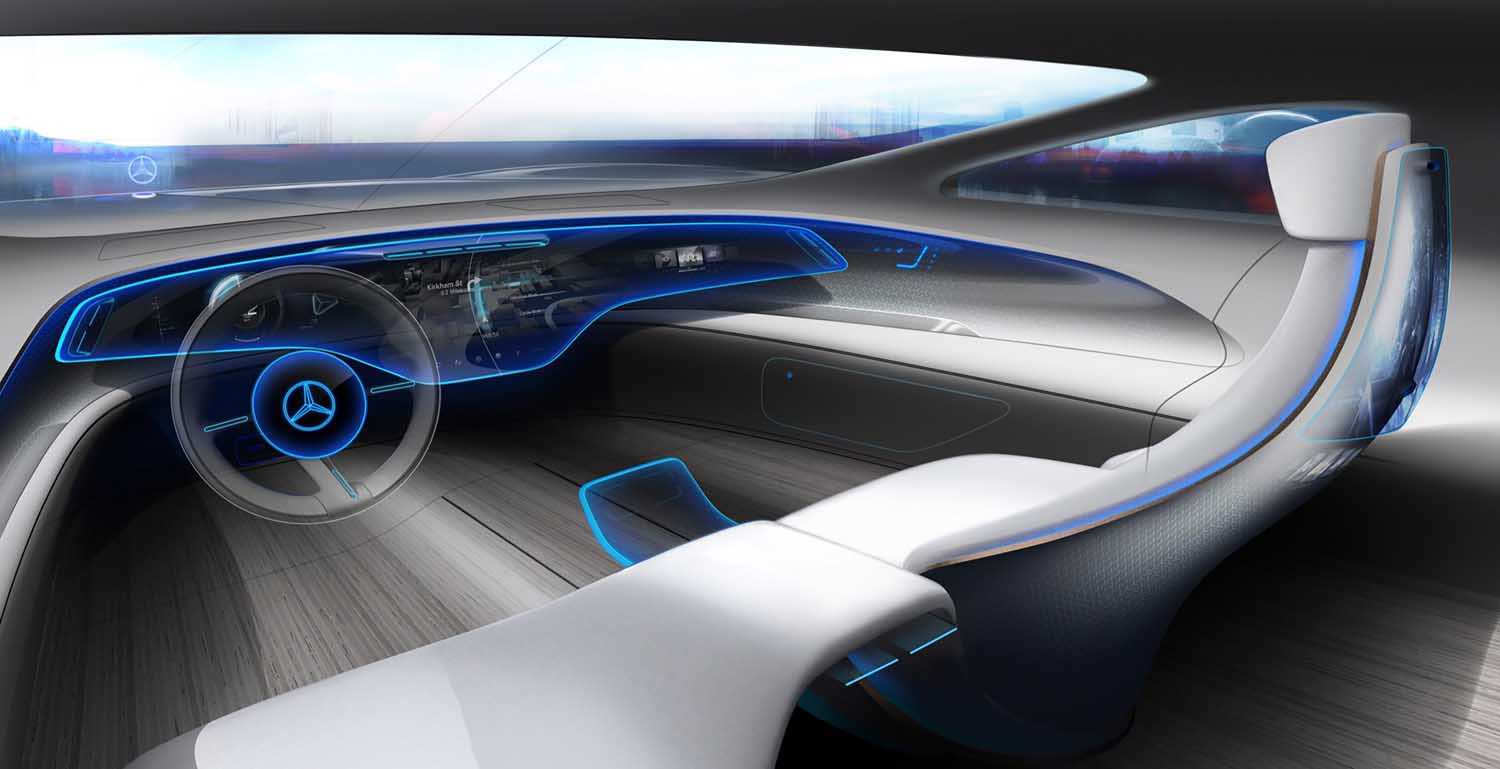
Between comfortable tranquillity and an interactive, sensuous sound experience
The new EQS: sound experiences
Electric cars are inherently quiet. If desired, the ride in the EQS nevertheless becomes an acoustic experience: the sound experts from Mercedes-EQ make the paradigm shift from combustion engine to electric car audible with a holistic sound production. An optional interior driving sound is available. It adjusts adaptively to the driving style and drive program.
A variety of soundscapes allows for an individual acoustic set-up. If the Burmester® surround sound system is on board, the EQS comes with the two soundscapes Silver Waves and Vivid Flux. Silver Waves is a sensuous and clean sound. Aimed at EV enthusiasts, Vivid Flux is crystalline, synthetic yet humanly warm. They can be selected or switched off as sound experiences on the central display. The additional soundscape Roaring Pulse can be activated as an over-the-air update. This sound experience is reminiscent of powerful machines, and is sonorous and extroverted.
Driver and passengers are already greeted acoustically when approaching the vehicle and when getting in. A corresponding aura sound also accompanies exiting and locking the EQS. Also part of the particular soundscape is the driving sound, which is reproduced by the speakers in the interior. It stirs emotions and inspires. At the same time, the driving sound is interactive, as it responds to a good dozen parameters such as the accelerator position, speed or recuperation. The choice of drive program also influences the driving sound; in SPORT mode, for example, the sounds become more dynamic and further effects are activated. Intelligent sound design algorithms calculate the sounds inside the amplifier of the Burmester® surround sound system in real time, and the loudspeakers reproduce them.
The algorithms and sounds for the sound design are created in-house at Mercedes-EQ. In addition to physicists, the interdisciplinary team also includes sound designers, media designers and mechatronics specialists. In the acoustics laboratory, which is completely shielded from external noise and vibrations, they work on the sound of the EQS and its model siblings. The sound experts determine which emotions the soundscapes evoke in real traffic during test drives. The mobile listening tests take place with interactive demonstrator vehicles, including at the new Immendingen Test and Technology Centre (PTZ).
In order to achieve an interplay between the driver’s action, the vehicle’s reaction and the feedback of the sound, musical composition such as harmony theory is not the only foundation. The liveliness of the soundscape varies as the result of many sound dimensions. In this way, the sound design creates a holistic, multi-sensory experience that interacts with the entire vehicle. This experience is in the conflicting area between comfortable quiet and precise feedback with emotionally appealing design.
HEPA filter against airborne pollutants
The new EQS: ENERGIZING AIR CONTROL Plus
Unfortunately, we have to stay outside, says the EQS to fine dust, microparticles, pollen and other substances. This is because its HEPA filter (High Efficiency Particulate Air) cleans the incoming outside air at its very high filtration level. In recirculation mode, the air is filtered by the cabin air filter of the automatic climate control system. Sulphur dioxide and nitrogen oxides as well as odours are also reduced thanks to the activated charcoal coating on the HEPA filter and the cabin filter. The HEPA filter is part of the optional equipment ENERGIZING AIR CONTROL Plus and uses the space under the front bonnet of the EQS. It bears the “OFI Quality Seal ZG 250-1” in the area of viruses and bacteria.
The system is based on filtration, sensors, a display concept and air conditioning. In combination with the intelligent fresh air/recirculating air switching, ENERGIZING AIR CONTROL Plus ensures good air in the vehicle interior. The particulate levels are also displayed in real time in MBUX. Using pre-entry climate control, it is also possible to clean the interior air before getting into the vehicle.
Thanks to its purpose design, the EQS accommodates a large filter system under the front bonnet. At 596/412/40 millimetres, the HEPA filter has nearly the surface area of an A2 piece of paper (420/594 mm), which is about four times the size of an A4 piece of paper. At 9.82 dm³, its volume is almost ten litres. Filtration takes place in three stages. A coarse pre-filter retains leaves, snow and sand and traps larger particles. At the same time, it protects the HEPA filter from a high concentration of coarse particles. The separation in this HEPA (High Efficiency Particulate Air) filter uses a mechanical process by means of a synthetic membrane: The microfibre layer traps fine dust of the so-called class PM 2.5 to PM 0.3 – these particles are therefore smaller than 2.5 μm. Over 99.65 percent of particles of all sizes are removed according to the filter’s efficiency certified pursuant to DIN EN 1822. The reduction of pollutants achieved at the filter is comparable to that in clean rooms and operating theatres.
In the third and final step, further fine particles as well as sulphur dioxide, nitrogen oxides and unpleasant odours are filtered out. The filtration of sulphur dioxide and nitrogen oxides is carried out by special activated charcoals in the HEPA filter and the cabin filter. Due to their pore structure, they have a very large inner surface area. Around 600 grams of activated charcoal are used in the HEPA filter of the EQS. The adsorption area is equivalent to about 150 football fields. Activated charcoal is produced from coconut shells, which are a by-product of the cosmetics industry.
Mercedes-Benz was the first car manufacturer to receive the “OFI Quality Seal ZG 250-1” from the Austrian Research and Testing Institute (OFI). Air filters with this certificate reduce bacteria and viruses particularly effectively directly at the filter. To prove their quality, the air filters must pass standardized tests and are checked using additional scientific analyses. The test results certify that ENERGIZING AIR CONTROL Plus has
- A virus capturing capacity of more than 86 percent in new condition
- A virus capturing capacity of more than 80 percent in aged condition after climate change test with different temperatures and humidities
- A bacteria capturing capacity of more than 90 percent in new condition
- A bacteria capturing capacity of more than 88 percent in aged condition after climate change test
- A very low re-shedding of filtered viruses on the back of the filter below the infection threshold
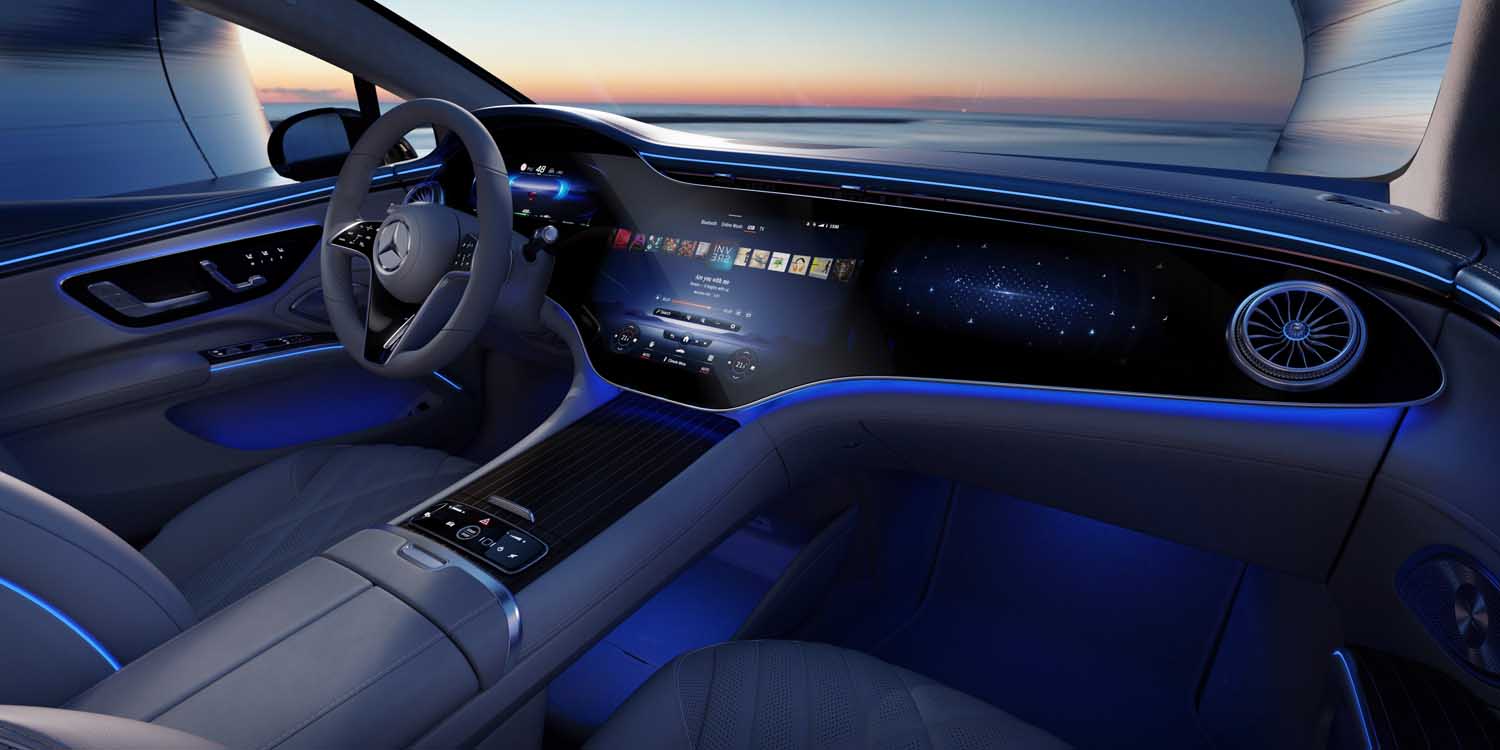
Always informed: indication of fine dust values outside and inside the vehicle
Combined with the automatic fresh air/recirculating air mode, ENERGIZING AIR CONTROL Plus ensures good air quality inside the vehicle. The air-conditioned recirculated air is filtered several times in recirculation mode, and flushing with fresh air takes place at regular intervals. Using pre-entry climate control, it is also possible to clean the interior air before getting into the vehicle.
The particulate levels outside and inside the vehicle are also displayed in MBUX. They can be viewed in detail in the dedicated Air Quality menu. If the quality of the outside air is low, the system can also recommend closing the side windows or the sliding sunroof.
No.6 MOOD Linen: fig meets linen
The active fragrancing of the EQS, which is part of the AIR-BALANCE Package, also appeals to the sense of smell. A special fragrance was composed for the new electric top-of-the-range model: No.6 MOOD Linen. Fig provides a green note for this fragrance, which is rounded off with linen. It gives the slight impression of a fig tree standing at a high elevation and surrounded by fresh, cool air.
The new nomenclature of the Mercedes fragrances is composed of an iconic number of the respective brand, the designation “MOOD” and the main ingredient of the fragrance. The Mercedes-EQ fragrances bear the number 6, as the first electric cars were added to the model range in 1906 with the “Mercédès Electrique” vehicles. Their electric wheel hub motors were powered by a battery. They were available as passenger cars, trucks, buses, ambulances and fire engines in a wide variety of designs.
Acoustic oases with summer rain, seagull sounds and rustling leaves
The new EQS: ENERGIZING COMFORT
ENERGIZING COMFORT reaches the next level in the EQS: the three ENERGIZING NATURE programmes Forest Glade, Sounds of the Sea and Summer Rain, are also new. These provide an immersive and impressively realistic on-board sound experience. These calming sounds were created in consultation with the acoustic ecologist Gordon Hempton. As with the other ENERGIZING COMFORT programmes, other senses are addressed with lighting moods and images. A new feature of the short sleep programme during a break is the expanded conditioning of the interior: It closes the roller blind of the panoramic sliding sunroof (optional extra) and moves the driver’s seat into the rest position. This creates an atmosphere that is conducive to sleeping. The power nap can increase the driver’s performance and give him/her new energy.
The new ENERGIZING NATURE programmes at a glance:
- Forest Glade: can help to escape the noisy daily routine and boost concentration. Birdsong, rustling leaves and a gentle breeze create a feel-good ambience. The programme is rounded off by warm music soundscapes and subtle fragrancing.
- Sounds of the Sea: can have a positive and relaxing effect through the combination of soft music soundscapes, wave sounds and seagull sounds. Warms and cools at the same time with the soothingly slow rhythm of the ocean waves combined with blasts of air from the air conditioning system.
- Summer Rain: can serve as an acoustic oasis in noisy traffic, cooling and calming with sounds of raindrops on leafy canopies, distant thunder, pattering rain and ambient music soundscapes.
The sounds are based on the audio library “Quiet Planet”, which the nature acoustician Gordon Hempton has created over the years. The Mercedes-Benz sound design department has arranged the sounds into ten-minute pieces and mixed them for the in-car experience. Individual musical compositions enhance the overall impression of the sounds of nature and their calming effect.

Power Nap: short recovery programme for the driver during a break
During a break in the journey, e.g. at a service area or charging station, the Power Nap programme can be selected. The programme has three phases – falling asleep, staying asleep, waking up – and can increase the driver’s performance and give them new energy. A new feature of the short sleep programme during a break is the expanded conditioning of the interior: the EQS ensures a sleep-promoting atmosphere by moving the driver’s seat into a rest position, closing the side windows and roller blinds, activating the ionisation of the fresh and recirculating air and adjusting the ambient lighting accordingly. Soothing sounds and the depiction of a starry sky on the central display support falling asleep – if Power Nap has been started for the front passenger seat, this also appears on the front passenger display.
Waking up is accompanied by a pleasantly activating soundscape, appropriate fragrancing as well as a briefly active, subtle massage and seat ventilation. Finally, the seat is raised again and the roller blind in the roof liner is opened. This ends the programme and returns the driver to the task of driving.
ENERGIZING COMFORT and ENERGIZING COACH: comfortable travel while staying fit
The ENERGIZING COMFORT range in the EQS builds on the further advanced system of the S-Class. In addition to the three new ENERGIZING NATURE programmes, it thus includes the programmes Freshness, Warmth, Vitality, Joy and Comfort as well as Training and ENERGIZING Tips.
Visualisation benefits from active ambient lighting and large screens with high-resolution animations. Passengers can join a programme in progress from their seat (“Join” mode) or suggest their own programme to other passengers (“Share” mode). The voice assistant “Hey Mercedes” is integrated. A statement such as “I am stressed”, for example, automatically triggers the Joy programme with regenerative character. If the driver says “I’m tired”, he/she is prompted to take a break and ENERGIZING COMFORT starts the Vitality programme.
The ENERGIZING COACH is based on an intelligent algorithm. It recommends the Freshness, Warmth, Vitality or Joy programme depending on the situation and individual. If the Mercedes-Benz vivoactive® 3 smartwatch, the Mercedes-Benz Venu® smartwatch or another compatible Garmin® wearable is linked, personal values such as stress level or sleep quality optimise the precision of the recommendation. Via the Mercedes me App, the smartwatch sends vital data of the wearer to the ENERGIZING COACH, e.g. pulse rate, stress level and sleep quality. The recommended comfort programme can be started directly from the suggestion in the form of a notification in the MBUX system. The aim is to ensure that the driver feels well and relaxed even during demanding or monotonous journeys. In addition, the pulse rate recorded by the integrated Garmin® wearable is shown in the central display.
Two ENERGIZING packages are offered for the EQS. The package contents:
- The ENERGIZING Package Front includes ENERGIZING COMFORT, ENERGIZING COACH, AIR-BALANCE Package, driver and front passenger seat climate control, steering wheel heating and the Multi-Contour Seat Package.
- The ENERGIZING Package Rear extends the ENERGIZING comfort control to the rear seats. It includes the Rear Seat Comfort Package, Rear Seat Package and Rear Seat Entertainment Plus.

Zero-layer design: the most important thing is now only one click away
The new EQS: MBUX (Mercedes-Benz User Experience)
MBUX (Mercedes-Benz User Experience) has radically simplified the operation of a Mercedes-Benz. Introduced in 2018 in the current A-Class, more than 1.8 million Mercedes-Benz passenger cars are now on the road with it, and the Vans division is also relying on MBUX. A few months ago the second generation of this learn-capable system debuted in the new S-Class. The new EQS is already the next big step. With teachable software, the control and display concept completely adapts to its user and makes them personalised suggestions for numerous infotainment, comfort and vehicle functions. With the so-called zero-layer design, the user does not have to scroll through submenus or give voice commands. The key applications are always offered on the top level in the field of vision, depending on the situation and context. This means that numerous operating steps are taken care of for the EQS driver. With the “Online Music” service, Mercedes-Benz has now fully integrated the major music streaming services into the MBUX infotainment system.
Infotainment systems offer numerous and extensive functions. Several operating steps are often required to control them. In order to reduce these interactive steps even further, with the aid of artificial intelligence Mercedes-Benz has developed a user interface with context-sensitive awareness.
The MBUX system proactively displays the right functions at the right time for the user, supported by artificial intelligence. The context-sensitive awareness is constantly optimised, both by changes in the surroundings and by user behaviour. The so-called zero layer offers the user dynamic, aggregated content from the entire MBUX system, and thus the associated services, on the uppermost level of the MBUX information architecture.
Mercedes-Benz has investigated the usage behaviour of the first MBUX generation. Most of the use cases fall in the Navigation, Radio/Media and Telephony categories. The navigation application with its full range of functions is therefore always in the centre of the visual display unit.
Over 20 other functions – from ENERGIZING COMFORT to birthday reminders to suggestions for the to-do list – are automatically offered with the help of artificial intelligence when they are relevant to the customer. The developers have internally christened these suggestion modules, which are displayed on the so-called zero-layer interface, “Magic Modules”.
Here are five representative use cases. The user can accept or reject the respective suggestion with just one click:
- When approaching a charging station that is enabled for Plug & Charge, the Magic Module ‘Charging’ automatically appears. The driver can then start charging immediately.
- If someone always calls one particular friend on the way home on Tuesday evenings, in future they will always receive a suggestion regarding this particular call on this day of the week and at this time. A business card appears with their contact information and – if this is stored – their photo. All the suggestions from MBUX are coupled with the profile of the user. So if someone else drives the EQS on a Tuesday evening, this recommendation is not made – or there is another one, depending on the preferences of the other user in each case.
- If the EQS driver regularly uses the massage function according to the hot-stone principle, the system automatically suggests the comfort function to them in wintry temperatures.
- If the user regularly switches on the heating of the steering wheel in addition to the seat heating, for example, this is suggested to them as soon as they activates the seat heating.
- The EQS’s chassis can be raised in order to offer more ground clearance. A useful function for steep driveways or raised points on the ground for traffic calming (“sleeping policemen”). MBUX remembers the GPS position at which the user has made use of the “Vehicle Lift-Up” function. If the vehicle approaches this GPS position again, MBUX suggests raising of the EQS.
MBUX: a milestone as the interface between driver, passengers and vehicle
The EQS features the current MBUX generation, which celebrated its première in the new S-Class only a few months ago. As standard, the new model is equipped with a 12.3-inch driver display and a 12.8-inch central display in portrait orientation. The impressive MBUX Hyperscreen (see next chapter for details) is available as an option. There, the front passenger also has his or her own screen.
Face recognition with cameras in the driver display is used for a wide range of assistance and comfort functions. These include biometric authentication, ATTENTION ASSIST fatigue warning and adjusting the exterior mirrors to the pre-set position. Also on board as standard: a fingerprint scanner for driver authentication.
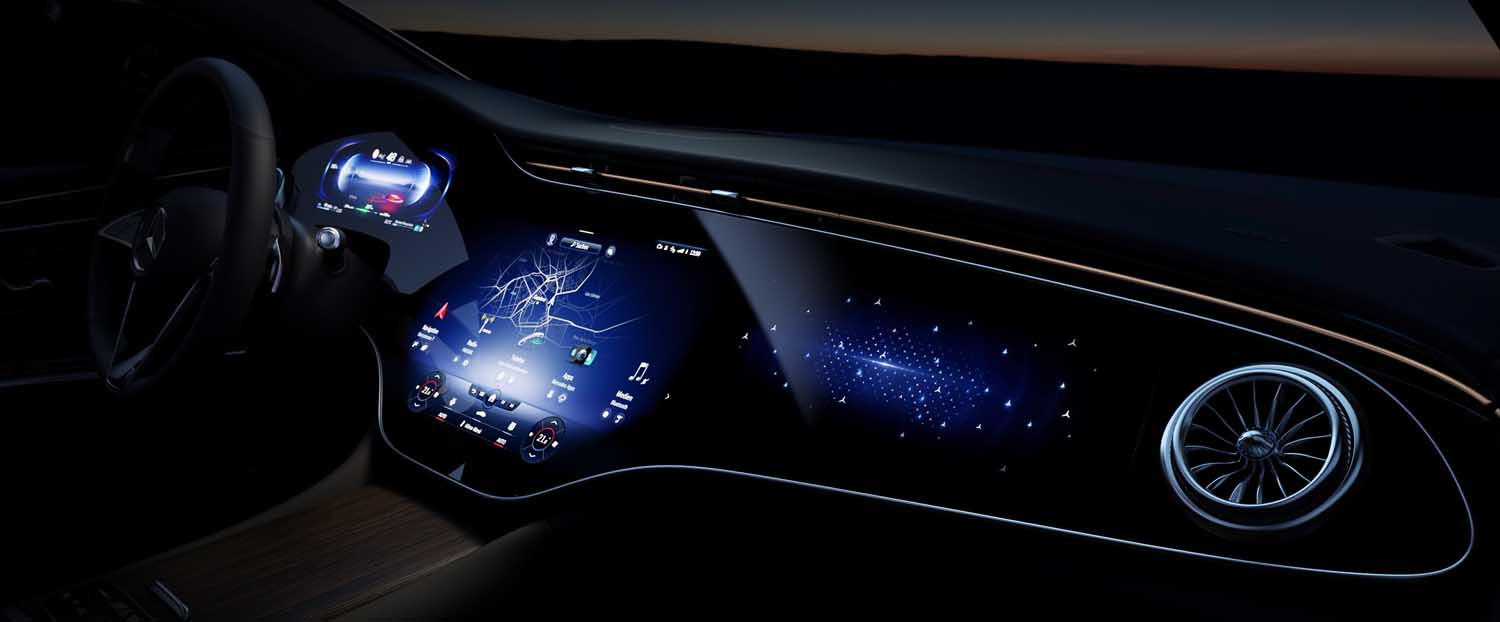
Hey Mercedes: the voice assistant can now do even more
Compared with the previous MBUX generation, the “Hey Mercedes” voice assistant is even more capable of dialogue and learning by activating online services in the Mercedes me App. Moreover, certain actions can be performed even without the activation keyword “Hey Mercedes”. These include taking a telephone call.
“Hey Mercedes” now also explains vehicle functions, and can help for example when asked how to connect a smartphone by Bluetooth or where the first-aid kit can be found. Compatible home technology and household devices can also be networked with the vehicle thanks to the smart home function and controlled from the vehicle by voice. “Hey Mercedes” is now also able to recognise vehicle occupants by their voices. Once the individual characteristics of the voice have been learned, this can be used to access personal data and functions by activating a profile.
The voice assistant in the EQS can also be operated from the rear. In general, rear passengers experience the same comprehensive infotainment and comfort offerings as the driver and front passenger. They have up to three touchscreen displays and a wide range of intuitive operating options.
MBUX High-End Rear Seat Entertainment Plus: comfort like in the front row
Screen content can be quickly and easily shared with other passengers. Selection and amendment of navigation destinations is possible from the rear seats. The MBUX High-End Rear Seat Entertainment Plus comprises two 11.6-inch displays with touch controls on the backrests of the driver and front passenger seats. The MBUX rear tablet is also optionally available. As a fully fledged tablet, this can also be used outside the vehicle and (Android) apps can be installed. With this convenient remote control, all rear seat entertainment functions can be comfortably controlled from any seating position.
Using cameras in the overhead control panel and learning algorithms, the MBUX Interior Assistant recognises and anticipates the wishes and intentions of the occupants. It does this by interpreting head direction, hand movements and body language, and responds with corresponding vehicle functions. As well as enhancing operating convenience, the MBUX Interior Assistant improves safety. If it is switched on, the vehicle exit warning of Blind Spot Assist is already issued when a hand approaches the door handle. It can also detect a child seat on the front passenger seat and signal on the central display if the vehicle seat belt is not buckled. Also available in the EQS is the MBUX Interior Assistant Rear.
Online music: music streaming with millions of songs to choose from
With the “Online Music” service, Mercedes-Benz has now fully integrated the major music streaming services into the MBUX infotainment system. MBUX enables access to the personal user profile at the linked music providers. This allows customers to access their favourite songs and playlists seamlessly and discover millions of songs and curated playlists. Operation is intuitive using the MBUX voice assistant via “Hey Mercedes” and via touch controls on the steering wheel or central display.
Personalisation is simple and convenient
A personal profile can be created directly in EQS and synchronised with existing profile data of the Mercedes me account. By scanning a QR code with the Mercedes App, the vehicle is automatically connected to the Mercedes me account.
Personal preferences such as a favourite radio station and preselected settings can be transferred to any seat via the personal Mercedes me profile. Up to seven different profiles with a total of around 800 parameters are possible in the vehicle. The ambient lighting can be individually set by remote configuration, e.g. from home. As the profiles are stored in the cloud as part of Mercedes me, the profiles can also be used in other Mercedes-Benz vehicles with the new MBUX generation.
In addition to the classic entry of a PIN, a special authentication procedure ensures a high level of security. Fingerprint, face and voice recognition are combined. This allows access to individual settings or verification of digital payment processes from the vehicle.
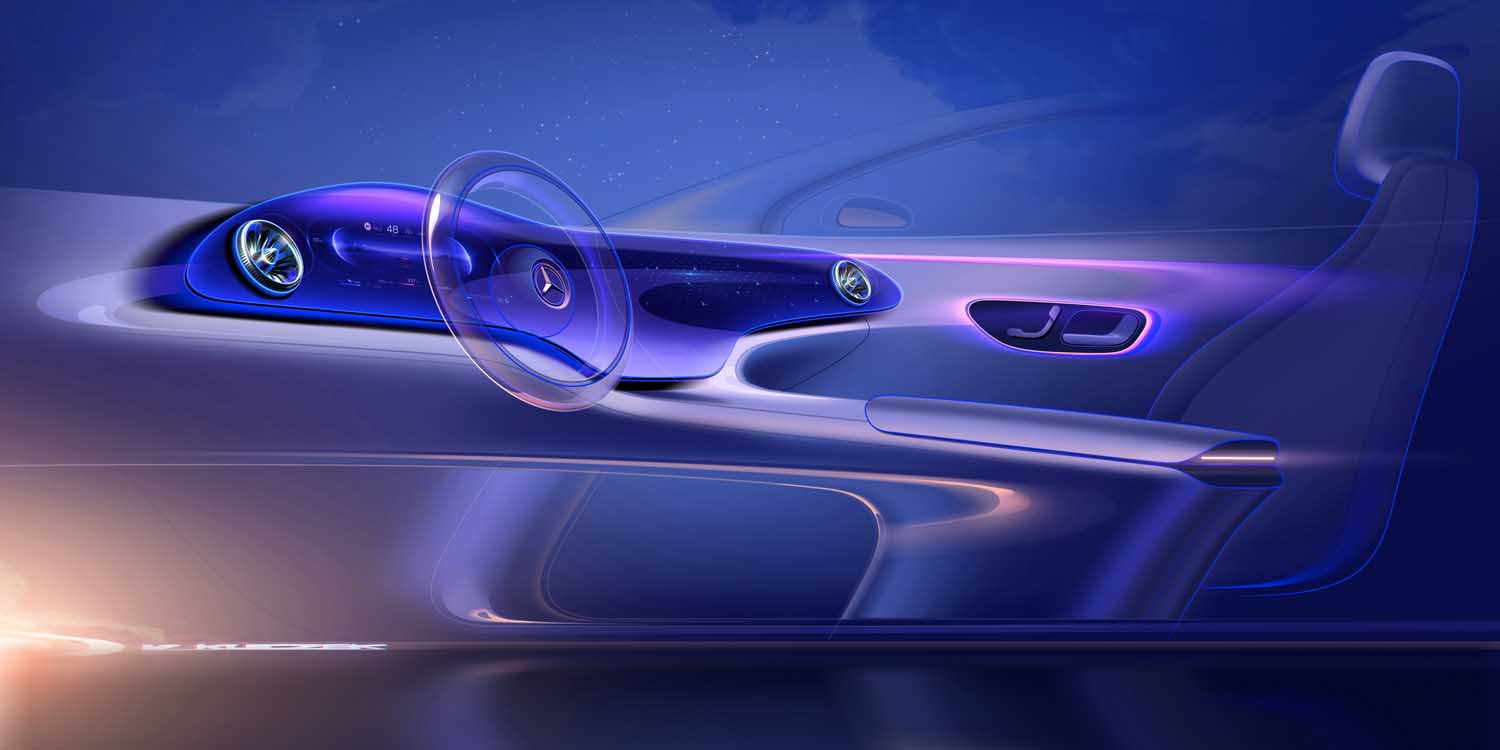
Welcome to the big in-car show
The new EQS: MBUX Hyperscreen
The MBUX Hyperscreen is the absolute highlight in the interior. This large, curved screen unit sweeps almost from A-pillar to A-pillar. Three screens sit under a common bonded cover glass and visually merge into one display. In addition to the so-called zero-layer design, the MBUX Hyperscreen offers intuitive touch operation with haptic feedback and force feedback. The scratch-resistant glass is coated to make cleaning easier.
With the MBUX Hyperscreen (optional extra), three displays merge almost seamlessly into one another to create an impressive screen band over 141 centimetres wide: Driver display (screen diagonal: 12.3 inch), central display (17.7 inch) and front passenger display (12.3 inch) appear as one visual unit.
The selected display style is shown uniformly on all screens; and the brightness is homogeneously adapted to the lighting conditions in the interior. The control panels for the automatic climate control system are located in the lower area of the central display. These remain permanently displayed so that the driver and front passenger can directly adjust the temperature and ventilation.
For particularly brilliant display quality OLED technology is used for the central and front passenger displays. This is where the individual image points are self-luminous; non-controlled image pixels remain switched off, which means that they appear deep black. The active OLED pixels, on the other hand, shine with a high colour brilliance, which also means high contrast values – irrespective of the perspective and the light conditions.
The central and front passenger displays also provide haptic feedback. When a finger touches certain spots on the touch screen, actuators (eight in the central display, four in the front passenger display) trigger a perceptible vibration of the cover glass. The user thus feels pulses on the smooth surface, which give the impression of a mechanical switch. Another operating aid known from high-quality consumer electronics products is the so-called force feedback of both displays. For this purpose, a metallised foam is integrated into the device as a force sensor. Different levels of pressure on the glass change the response. For example, MBUX then jumps to another menu level.
The 12.3-inch OLED display for the front passenger gives them their own display and control area, making journeys more enjoyable and entertaining. However, the entertainment functions of the front passenger’s display are only available within the framework of the national legal regulations during the journey. Mercedes relies on an intelligent, camera-based locking logic: if the camera detects that the driver is looking in the direction of the front passenger display, it is automatically dimmed when certain content is displayed. He/she then cannot look at them while driving. If the front passenger seat is not occupied, the screen becomes a digital decorative image. The customer can choose from various decorative patterns, including a starry sky, i.e. the Mercedes-Benz pattern.
The curved cover glass is made of particularly scratch-resistant aluminium silicate glass and is coated to make cleaning easier. For example, fingerprints can be easily removed with a microfibre cloth.
Ergonomic, sophisticated, robust: the development
During the development of the MBUX Hyperscreen, Mercedes-Benz engineers carried out extensive ergonomics studies with visual beams. The result is an optimised alignment of the MBUX Hyperscreen to reduce reflections caused by the curvature of the cover glass. In addition, the upper part of the windscreen is shaded by a tinted strip.
Other details designed with the typical Mercedes-Benz meticulousness include the brightness of all three screens, which is adjusted to the respective ambient conditions. A light sensor above the central display is used to determine the illumination level in the driver and front passenger areas. In addition, the camera integrated in the driver display measures the ambient brightness. Both the brightness and the image content of the displays are then adjusted. At the same time, this algorithm is less susceptible to scattered light and thus to misinterpretation of the measurement system.
Tolerance to high temperature differences, immunity to vibrations and protection against dust are among the tough automotive requirements for which the entire system has been designed. Age-related burn-in effects of OLED displays are countered with the help of various technical solutions. The ageing process of each individual pixel is permanently monitored and an automatic adjustment is carried out in the background to compensate for it. In addition, the displayed image information rotates slightly and imperceptibly counterclockwise to reduce permanent strain.
Curved, bonded and printed: the production
The large cover glass is curved three-dimensionally using the moulding process. This hot forming of glass at process temperatures of approx. 650°C places the highest demands on mould making and process control and is used in the production of optical glass for camera lenses and smartphone cover glasses. With the MBUX Hyperscreen, this process enables a distortion-free view of the displays across the entire of the vehicle, regardless of the radius of the cover glass.
All displays are transparently bonded to the cover glass for a uniform refractive index curve to avoid reflections as much as possible. The central and front passenger displays are optically connected to the cover glass under vacuum. This so-called dry bonding process uses an adhesive material similar to double-sided adhesive tape. The LCD driver display, which is flat due to its design, uses a wet bonding process in which the adhesive material is liquid to compensate for the radius of the cover glass.
The black areas between the screens are printed onto the cover glass from behind using a screen printing process specially adapted to the curvature. The colour of the black print was adapted to the reflection behaviour of the OLED displays in order to achieve a homogeneous overall impression in a wide variety of lighting situations. For certain important warning lights to the right and left of the driver display, a mask is used during the screen printing process to leave out the corresponding symbol.
The MBUX Hyperscreen is surrounded by a continuous front frame in plastic. This visible part is painted in “Silver Shadow” using an extensive three-coating process. This paint system achieves an especially high-quality surface impression through extremely thin intermediate coats. The integrated ambient lighting included in the lower section of the MBUX Hyperscreen appears to make the display unit hover on the instrument panel.
Extensive precautions: the safety measures
The MBUX Hyperscreen is bolted directly to the cockpit crossmember for stability: The connection to a stabilising magnesium support as the structural component of the MBUX Hyperscreen is made via aluminium brackets. Their honeycomb structure allows them to deform in a controlled manner in a crash. For reasons of side impact protection, the cover glass also does not extend all the way to the doors. In the event of a severe side impact, there are also predetermined breaking points behind the side air vents.
